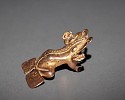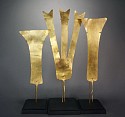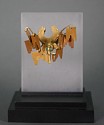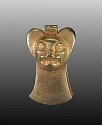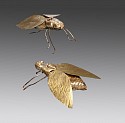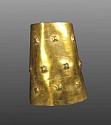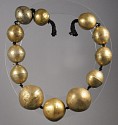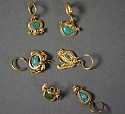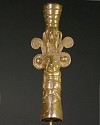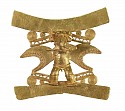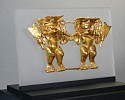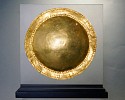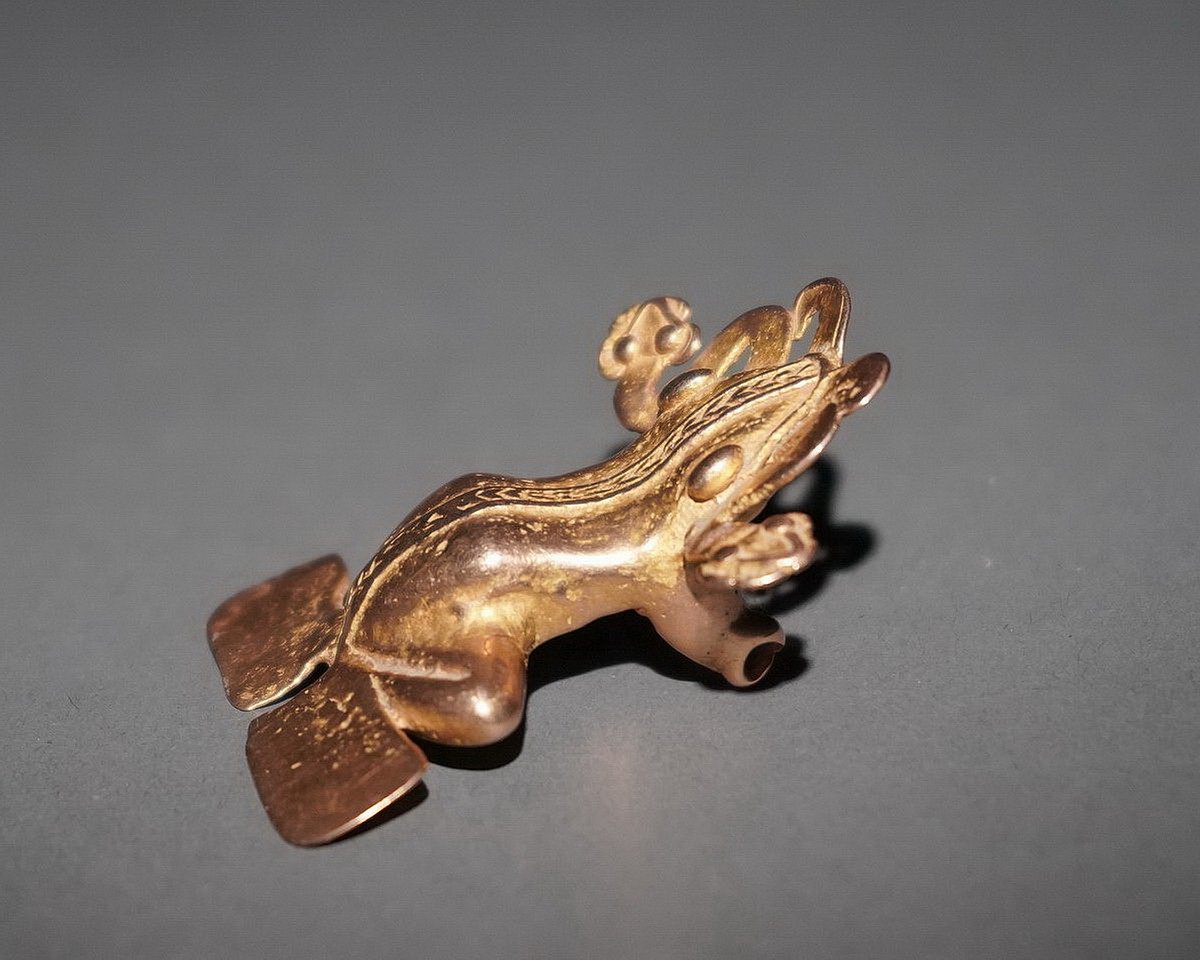





Panama, Classic Veraguuas Cast Gold Frog with Serpents
This beautiful cast gold frog has large spherical eyes and a ribbon down its back and bordering its flippers. There is a modern suspension loop hung from the original suspension arrangement. Jan Mitchell collection, prior to 1970, by descent to his sons.
Period: Panama, Veraguas, c. AD 1000
Media: Metal
Dimensions: Length: 2 7/8" x Width: 1 3/4" Weight: 32.4 grams.
$6,500
p1045a
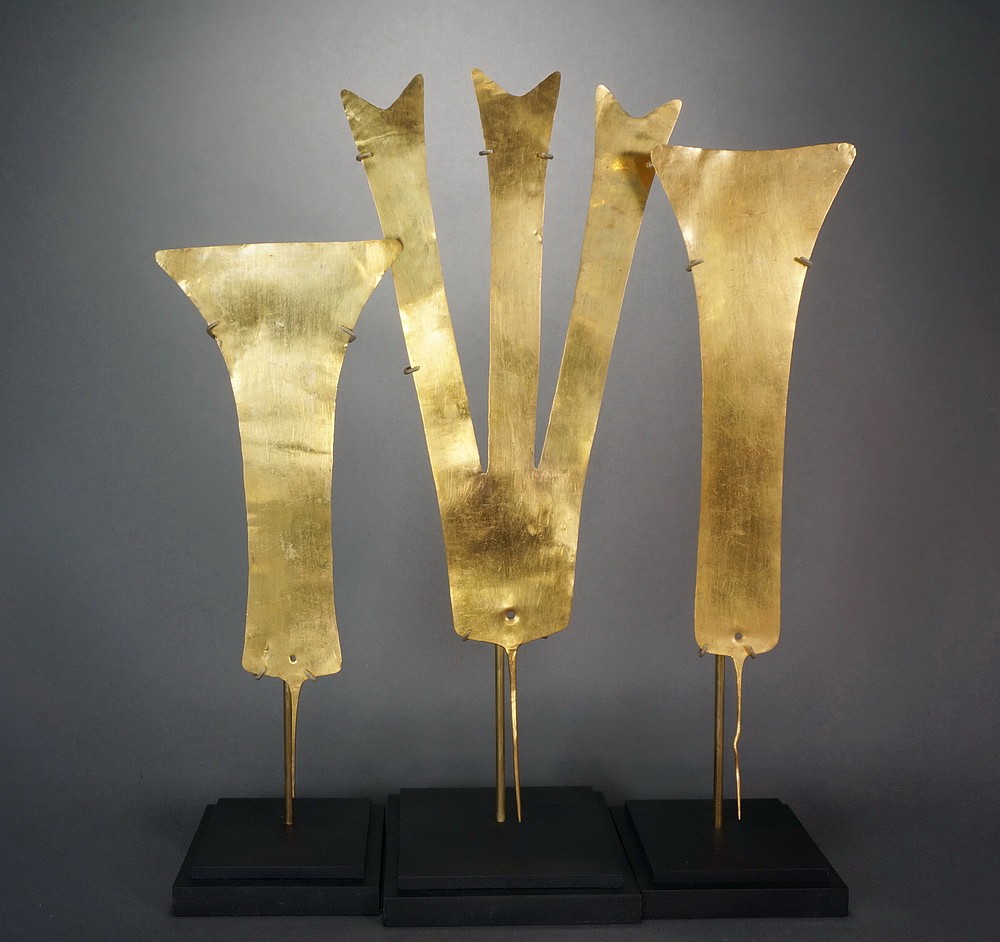




Peru, Three Chavin Gold Plumes for Headdress
Three hammered gold plumes were used as headdress or turban ornaments with tapering shafts. They were each fabricated from an individual nugget by repeatedly hammering and annealing. They are illustrated in TRUJILLO Precolumbino, Odebrecht-Lavalle, Editores 1990, pg 293. Other similar examples are illustrated in Oro del Antiguo Peru, pl. 51. These plumes are considered very large for early Peruvian goldwork.
Period: Peru, Chavin, Tembladera, Late Phase, North Coast, c. 900 - 200 BC
Media: Metal
Dimensions: Height: 9", 11", 12" Weight for the three 90 grams
XRF: Au.81, Ag. 9.5%, Cu. 10.1% average for the 3
Price Upon Request
94192
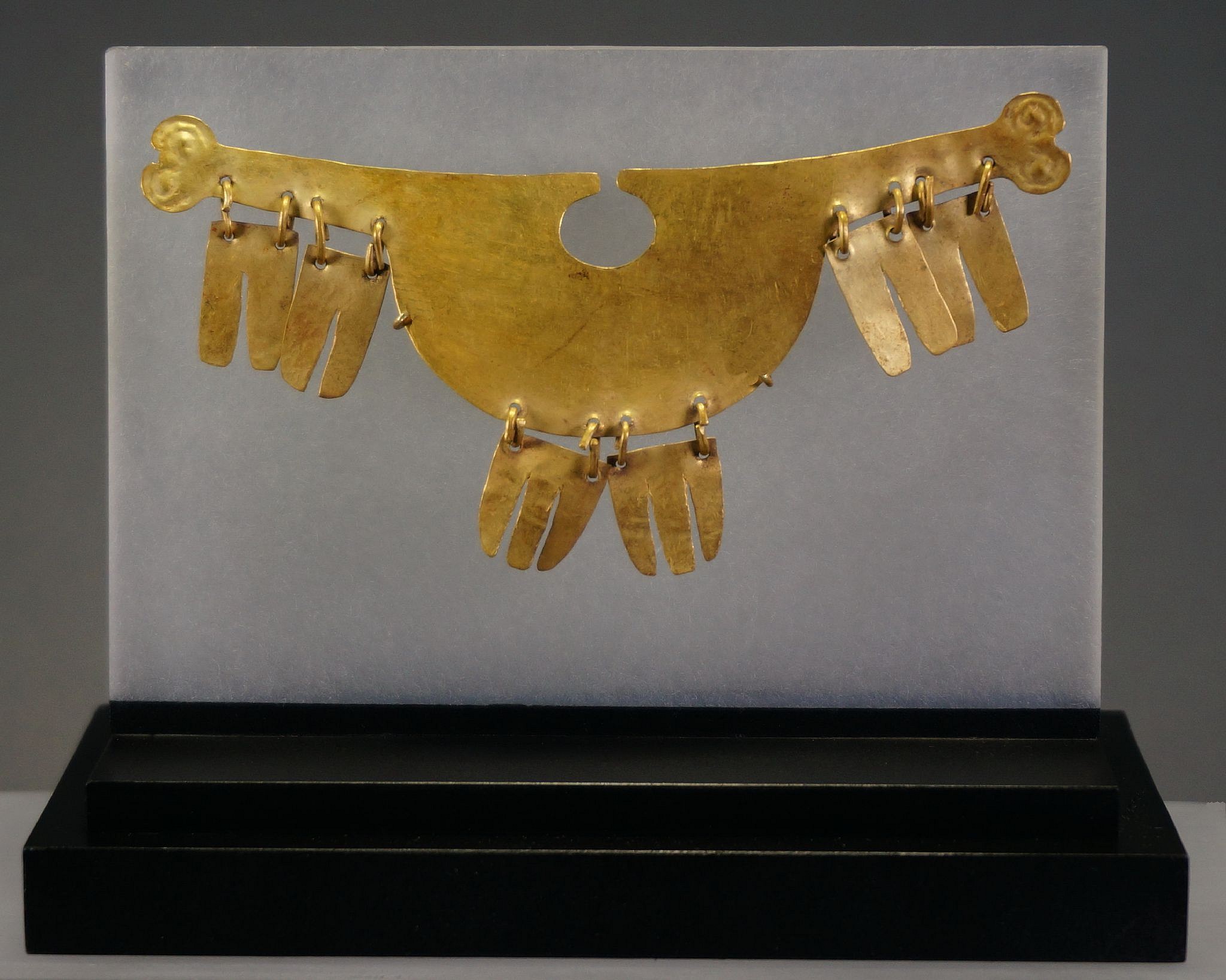


Peru, Salinar-Early Moche Gold Nose Ornament With Dangles in the Form of Bird Feathers
Unusual and rare nose ornament from the Salinar culture with stylized bird heads at each end and six dangles imitating feathers. A similar example is illustrated in "Oro del antiguo Peru" by José de Lavalle (1992: pl. 94).
Period: Peru, Viru, North Coast , c. 200 BC - AD 200
Media: Metal
Dimensions: Width 4" x Height 1 3/4"
Price Upon Request
96164
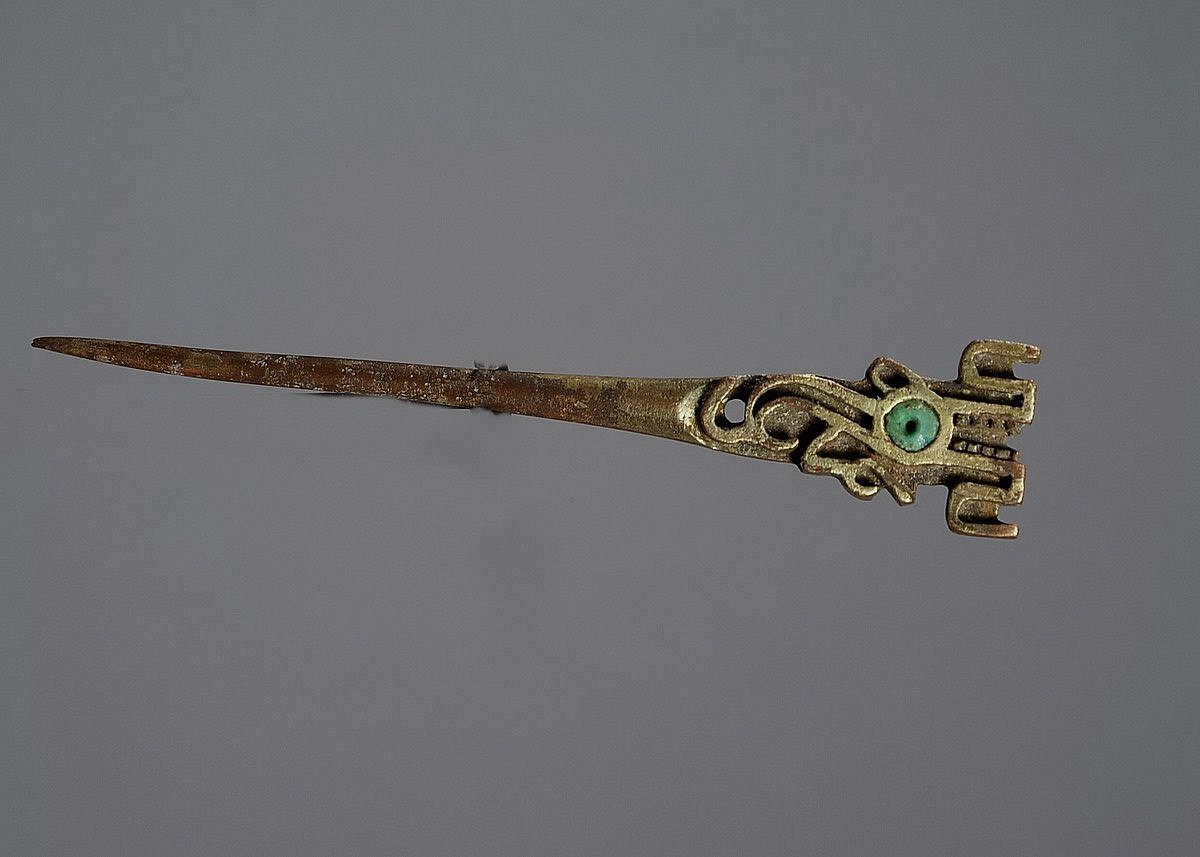





Peru, Recuay Gilt Copper Pin Decorated with the Moon Animal
This is a short tupú with a filigree design of the Moon creature, a North Coast deity invented by the Recuay and adopted by later societies. The creature may have been modeled after the Pampas Cat or the Andean Mountain Cat, a small feline that inhabits the region. The Recuay and Moche associated the Moon Animal with the crescent moon, stars and human sacrifice. There is a turquoise bead in the eye; other recessed areas of the casting also had inlays, which have been lost. Few Recuay gilded works have survived because the gilt tends to fall off over time. The Recuay had sophisticated techniques of metalworking, and this example is extremely well crafted. The gilding is thick (about 1mm). A similar pin was found at a Recuay site, and is on display at the American Museum of Natural History.
Period: Peru, Recuay, North Highlands, c. 300 BC - AD 700
Media: Metal
Dimensions: Length: 3 1/2" x Width at top: 5/8"
$1,700
M2029
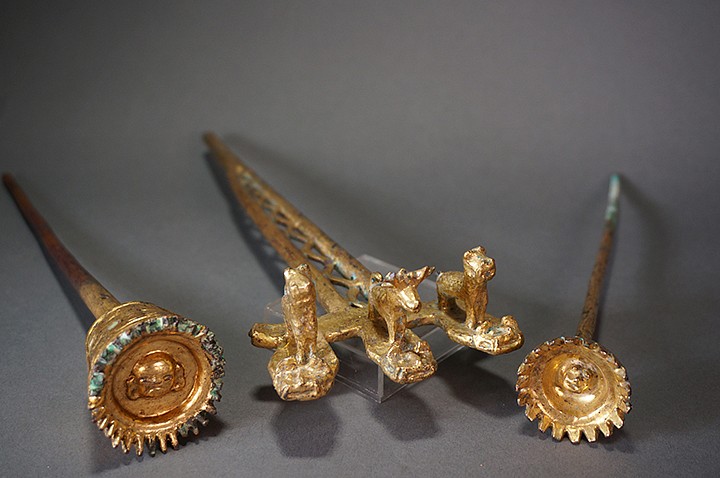








Peru, A Rare Recuay Gilt Scepter
This scepter is very rare with an unusual motif of three animals standing on three flayed feline skins. The central animal is a deer flanked by an unknown four-legged animal. The shaft of the scepter has two channels attached by a series of triangular soldered stock. Each channel has a suspension hole towards the top. This scepter must have belonged to a high status individual as its manufacture is very elaborate and technically sophisticated. Only one other known similar Recuay scepter is illustrated in Kultur Von Peru by Max Schmidt, pg. 392. The accompanying two tupus with decorated tops (longer and shorter) each have a different motif.
The longer tupu is decorated with a band of four stooping animals in low relief, each with a serpent emanating from its head. The inside of the the longer tupu’s upper cup is decorated with a frowning face, perhaps a mask. This is one of the largest known intact tupus. The smaller tupu has a rich gilt surface and is decorated with a band of two face masks. Inside the upper cup of the small tupu is the head of the same animal flanking the deer on the scepter. Both tupus have finials that are decorated with both an outside band and an inside head. The larger one has a band of 3 double headed serpents with a fox head inside. The smaller one has a band of a double-headed arched feline and a face inside.
Four tupus excavated at Pashash, the earliest known Recuay site, are illustrated in The Art and Archaeology of PSAHASH by Terence Grieder, figs. 114-117, and fig. 7. These tupus were originally sold by Alan Lapiner in the early 1970s along with a classic Recuay vessel of a lord flanked by arched felines on each side.
Period: Peru, Recuay, North Highlands, c. 300 BC - AD 700
Media: Metal
Dimensions: Scepter Length 9" x Width 3"
Longer Tupu Length 8 ½ x diameter 1 ½â€
Shorter tupu: Length: 7 ½†x diameter 1"
Price Upon Request
M3023
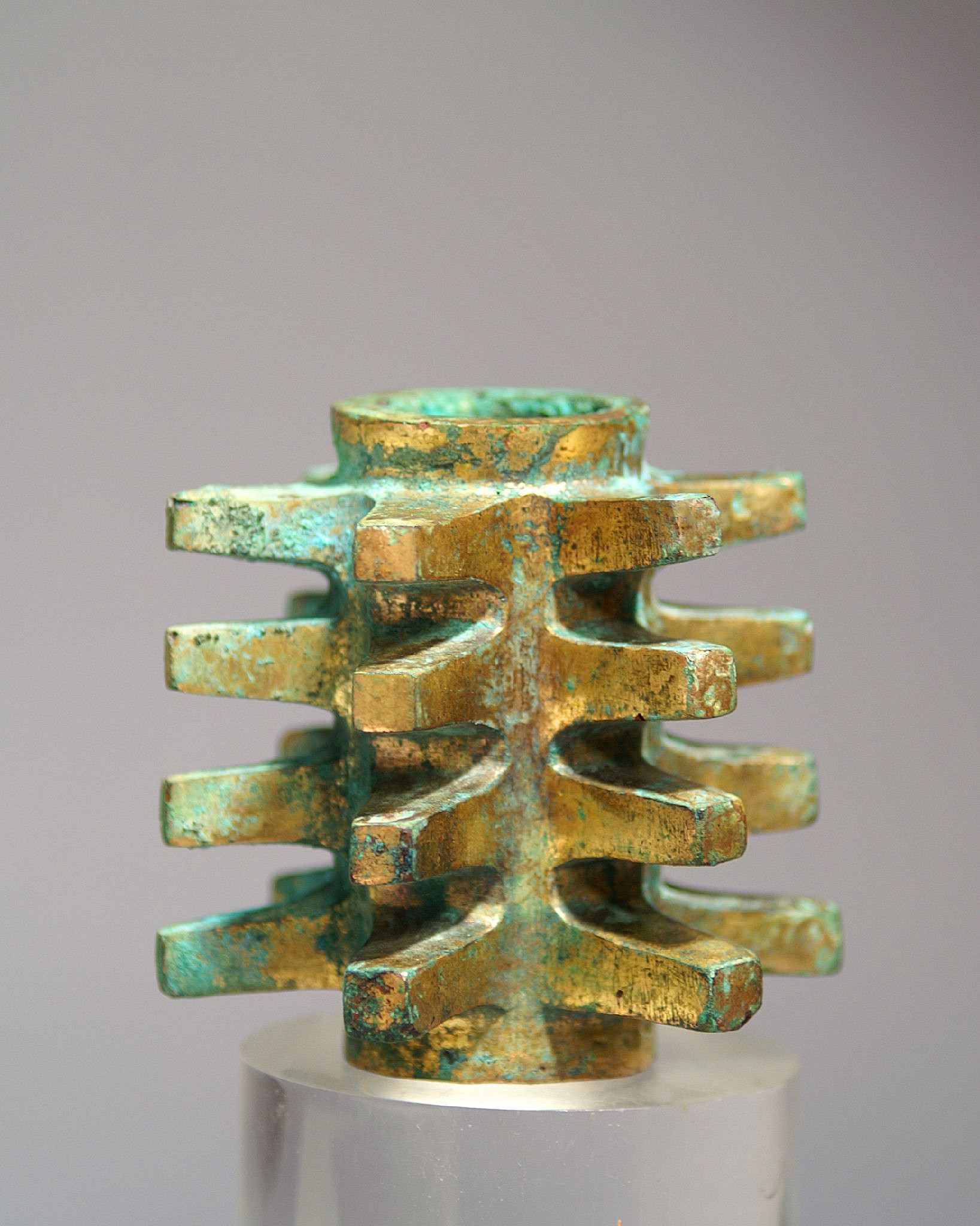


Peru, Vicús Gilt Copper Mace Head with four Levels of Six Pointed Stars
The mace has a richly gilded surface with traces of malchite corrosion inside and out. A similar mace with only three layers of stars and less intact gilt is illustrated in Mufareche (1999: #132). Mace heads were attached to wooden shafts and used as weapons. This is a particularly fine example from the early Vicús culture.
Period: Peru, Vicus, Far North Coast, c. 300 BC - AD 300
Media: Metal
Dimensions: Diameter 3" x length 3 5/8"
Price Upon Request
M3053
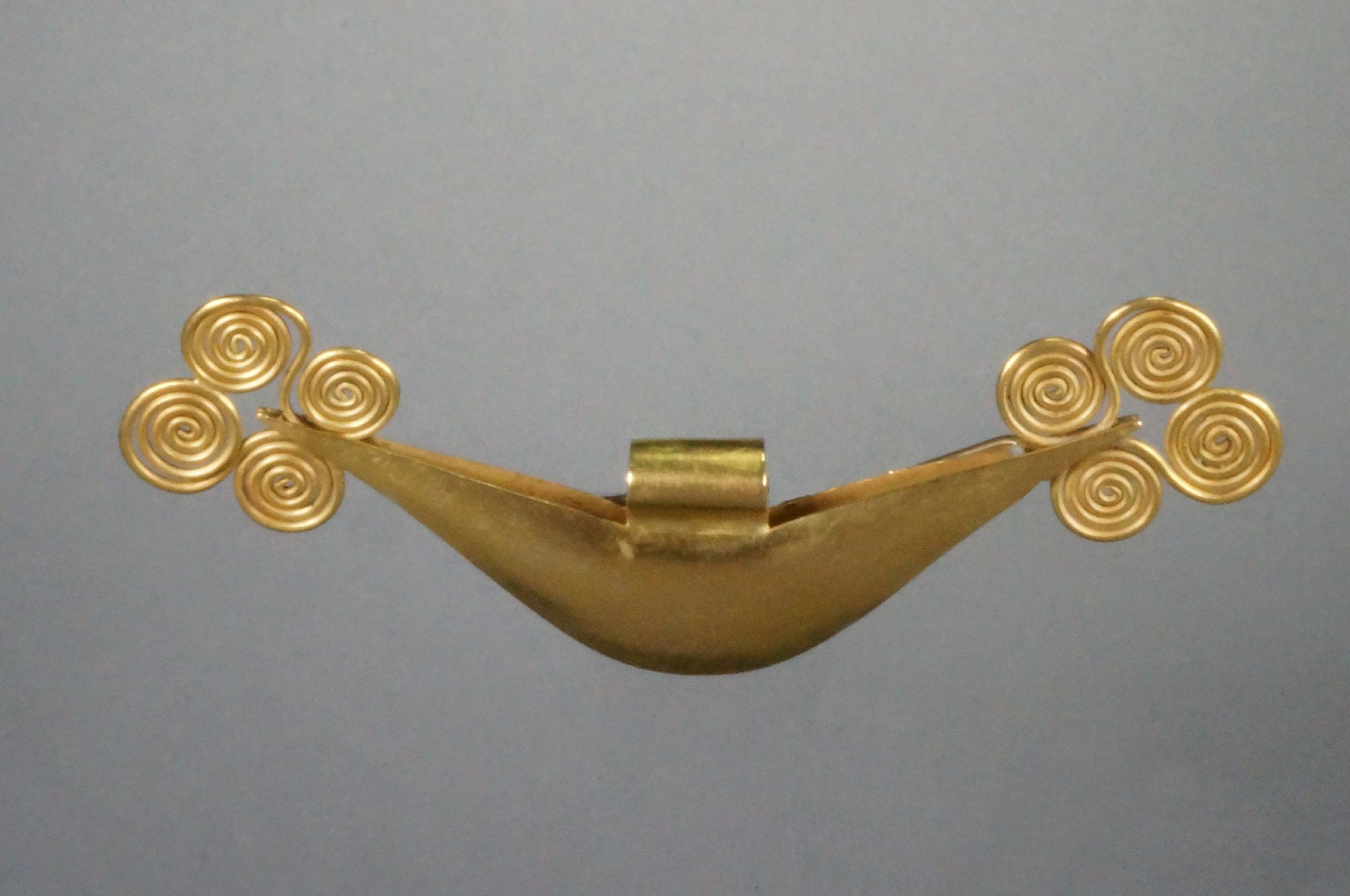


Peru, Vicús Gold Crescent Tweezers with Four Spirals on Each End
An elegant gold nose ornament with four wire spirals expertly soldered on each end. Made of two oblong sheets of gold with soldered filigree spirals reveals a high degree of craftsmanship. Tweezers were status implements fabricated in copper, silver and gold, with gold reserved for the highest level of status. Tweezers are often confused with nose ornaments, however they are spring loaded by annealing the metal, and were used to pluck the thick facial hairs of the Andean people. Shaving was not done in the New World, but was widely practiced in Europe and the Middle East.
Period: Peru, Vicus, Far North Coast, c. 300 BC - AD 300
Media: Metal
Dimensions: Width 6" Weight: 36.5 grams
XRF: Au. 83.8%, Ag. 20.0%, Cu.5.1%
Price Upon Request
96050




Peru, Moche Gold Nose Ornament with Hummingbird in a Tree
This delicately crafted hummingbird figure features inlaid turquoise eyes and geometric danglers. This is an excellent example of Moche soldering and filigree workmanship
Period: Peru, Moche, North Coast, c. AD 100 - 300
Media: Metal
Dimensions: Width: 1 1/2" x Depth: 1 1/2" Weight; 8 grams.
•SOLD
90166



Peru, Moche Gold Pincer with Embossed Large-Eared Bat Face
Pincers have been found from as early as the Vicus period (pre-Moche), circa 300 BC and were thought to be used to pluck facial hair. Few are known from the Moche period and most of the pincers that have been found were from the Chimu and Inca periods. This pincer has an embossed face of a bat with fanged teeth. The bottom of the pincher features a beautiful, flared design, representing a Moche back-flap. It was made from one single hammered sheet of high carat gold and then embossed twice on a carved wood form, then bent at the middle to create an identical front and back. There is a suspension hole in the middle. Ex. collection Magret Brenner, Zurich.
Period: Peru, Moche, North Coast, c. AD 200 - 700
Media: Metal
Dimensions: Height: 2 1/4" x Width: 1 1/4" Weight: 16.5 grams.
$9,750
n7012
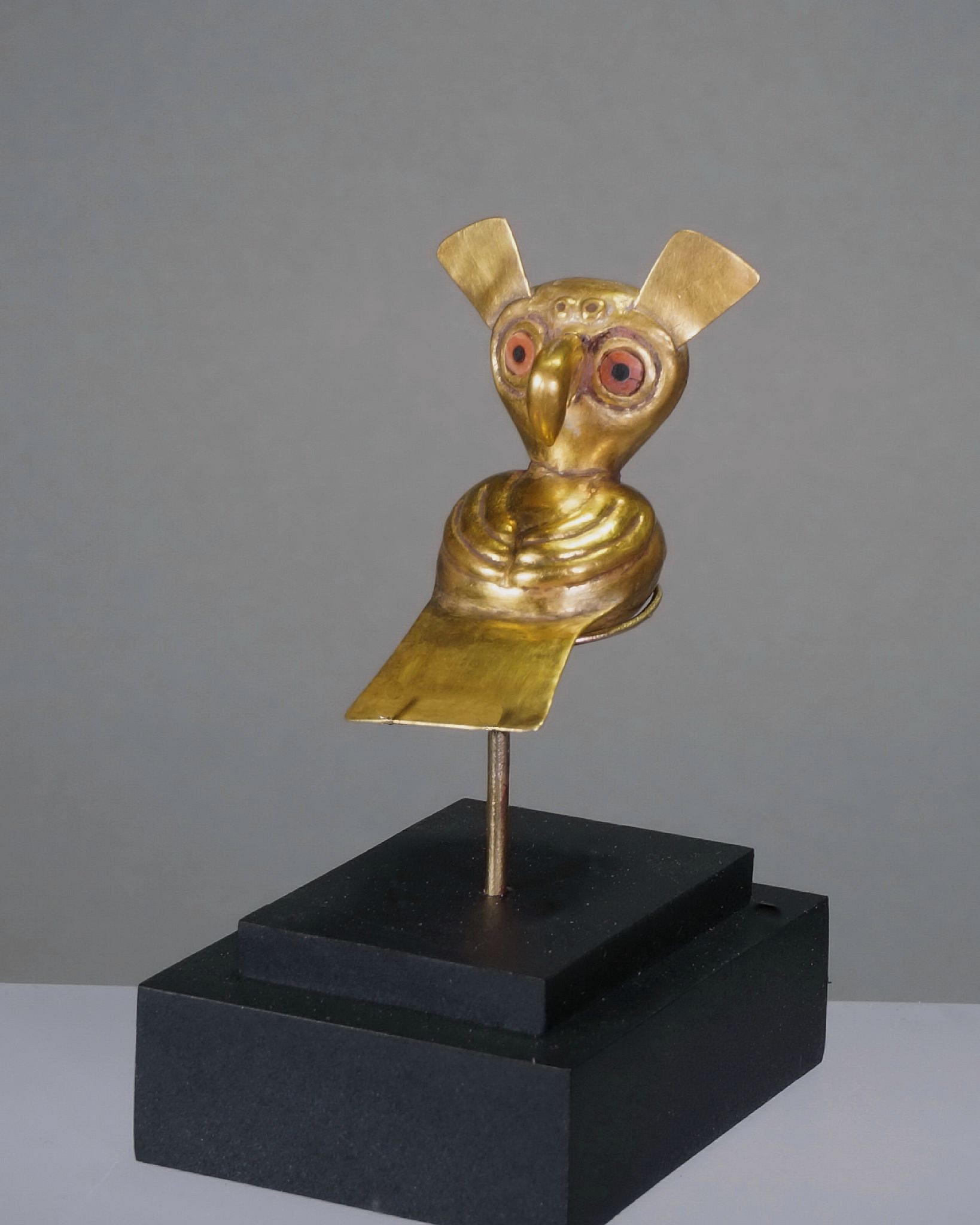



Peru, Early Moche Gold Owl Ornament or Necklace Element
This ornament portrays a stylized horned owl. The owl was revered by the ancient people for its special characteristics, such as silent flight, strong talons, and its ability to rotate its head 180 degrees. This gold owl has two suspension holes to the lower rear, which would have allowed it to hang looking downward. It is constructed from flat pieces of sheet gold that were hammered and beaten into repoussé parts, and then soldered together. Such three-dimensional forms were characteristic of the Transitional phase of gold work on the North Coast after the collapse of the ChavÃn culture. The eyes are made from Spondylus beads.
Period: Peru, Late Chavin/Early Moche, Transitional Phase, North Coast, c. 200 BC - AD 200
Media: Metal
Dimensions: Height: 1 1/4" X 1 1/4"/ Weight: 10 grams
Price Upon Request
M7015




Peru, Three Moche Bi -Metallic Nose Ornaments
These ornaments are excellent examples of the Moche metalsmiths’ ability to use depletion gilding to vary the surface area with both gold and silver decoration. The Moche believed that metal possessed sacred power, and according to their cosmological myths, the process of bringing the silver and gold colors to the surface revealed the metal’s spiritual qualities. A similar nose ornament is illustrated in ANTIGUO ORO DEL PERU, pg. 15. Private collector, Florida, prior to 1980.
Period: Peru, Moche, North Coast, c. AD 100 - 600
Media: Metal
Dimensions: Width 4 3/4" Weight 24 grams.Width 3 5/8" Weight 13.8 grams.Width 3 7/16" Weight 14.8 grams.
$12,500
M5027
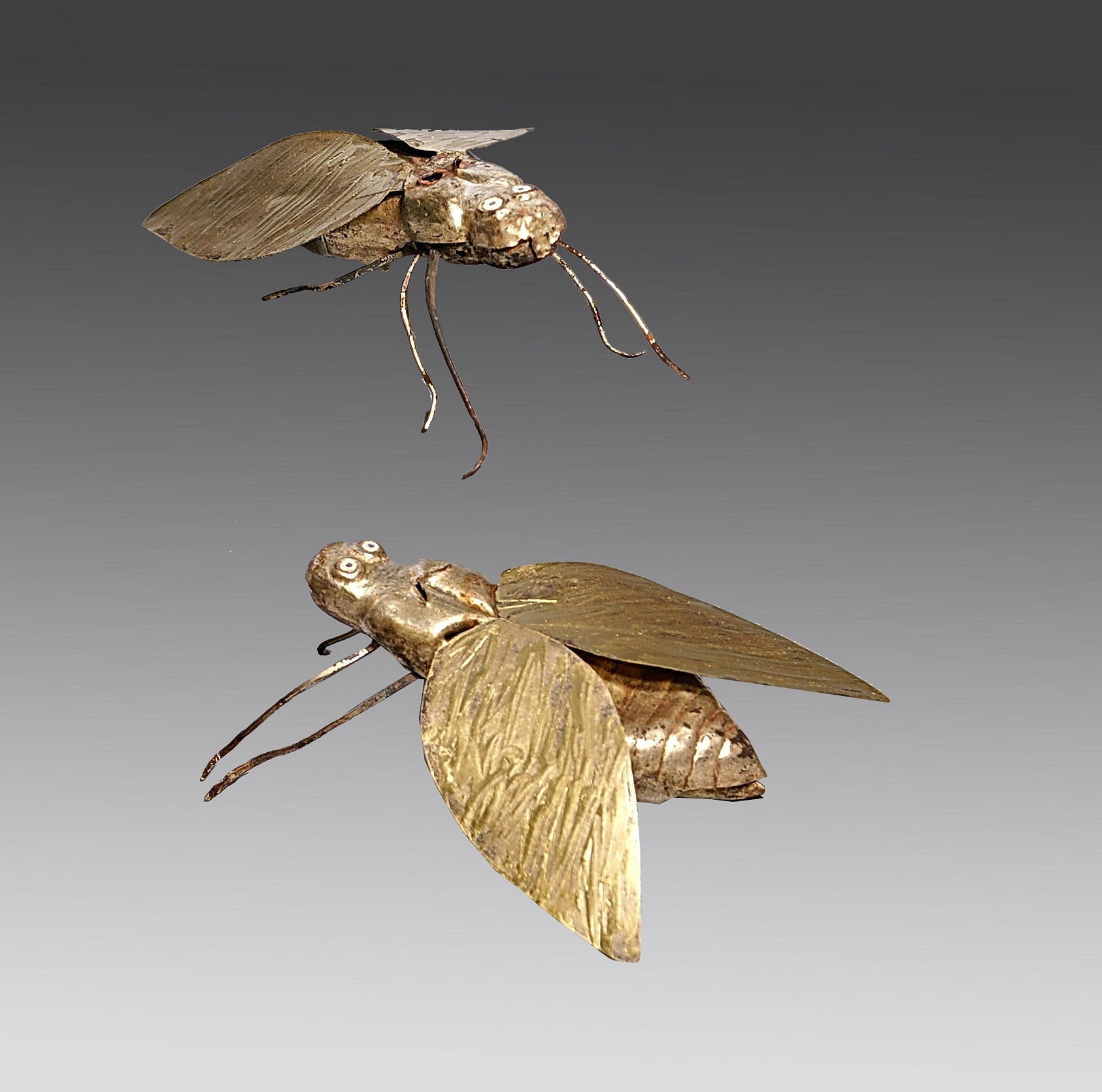




Peru, Loma Negra Gilt Copper Pair of Hoverflies
The flies are examples of a highly skilled gilding technique over copper. The construction is of tab and hammered and shaped parts to create a three-dimensional body. This was preferred in Peru over lost wax casting. Loma Negra Royal tombs were found in Northern Peru in the 1960's. The largest holdings of this material are in the Metropolitan Museum of Art. Other examples of critters are illustrated in PRE-COLUMBIAN ART of South America by Alan Lapiner, fig 376. There is a Loma Negra fly in the Met Museum ref 1981.459.28 in poor condition. Hoverflies are among the largest flies and have colorful bodies and are harmless. They often imitate bees or wasps as a survival technique to appear dangerous to their predators. The Peruvian favored animals that metamorphose, (eggs, large, maggots to flies) as proof that humans can transcend into spirits. Since hoverflies have colorful yellow and black bodies they connect with gold of the sun. These flies are considered large for Loma Negra creatures and have no apparent function.
Period: Peru, Moche, Loma Negra, North Coast, c. AD 100 - 400
Media: Metal
Dimensions: Length 4 1/2" x Width with wings 4" Height :1 1/2"
$15,000
M9067
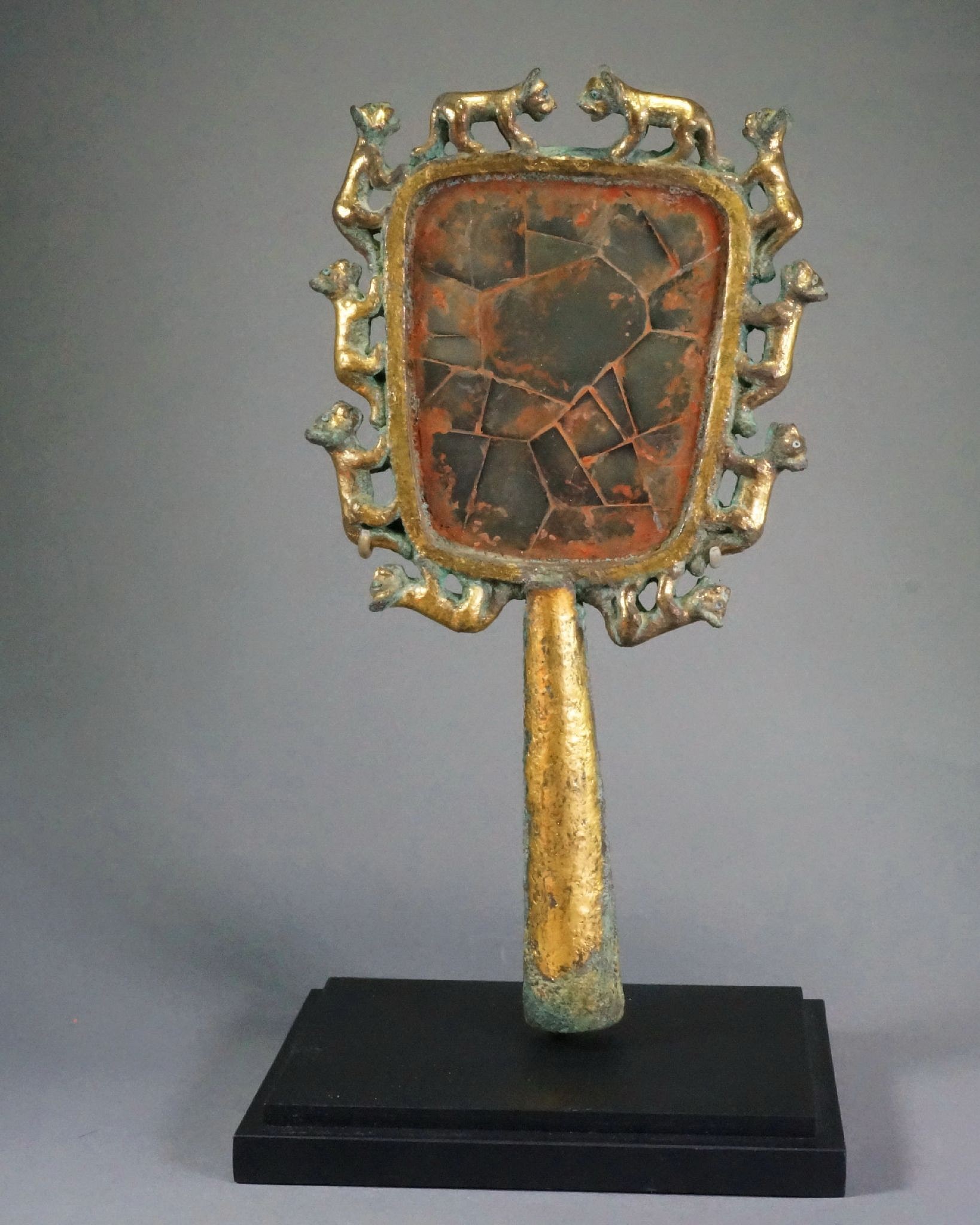




Peru, Moche Cast Copper Gilt Handled Mirror Surrounded by Ten Pumas
Hand-held mirrors are rare from any Peruvian cultures, and those few that are known are carved from wood, except one other gilt copper one that is in the Metropolitan Museum of Art. Mirrors were important objects for high status individuals and symbolized the power of the sun. Both mirrors were found at the Loma Negra site of far North Peru, excavated in the 1960’s, and were made by the same workshop. The mirrors have different themes: the Met’s with birds, and this one with felines.
Both mirrors were constructed in the same manner - cast frames are mechanically attached to the handle with a separate sheet of copper backing to hold pyrite mirror fragments in place. The Met’s mirror has lost most of its original gilding. This mirror has more of the original gilt surface intact and has a reconstructed mirror of ancient pyrite, whereas the Met’s mirror was restored with wax and coated with silver foil. The felines surrounding the frame were individually modeled and cast as one with the frame, an extremely difficult technical accomplishment. Each puma has carved turquoise eyes. The few other known mirrors with handles which have been found were carved from wood. There are no other known mirrors with metal frames according to Dr. Christopher Donnan formerly at UCLA and the world expert on Moche Art.
To read an essay about this mirror, click here.
Period: Peru, Loma Negra, North Coast, c. AD 100 - P300
Media: Metal
Dimensions: Height: 9 1/4"(23.5cm) x Width: 5"(12.6cm)
Price Upon Request
n7005
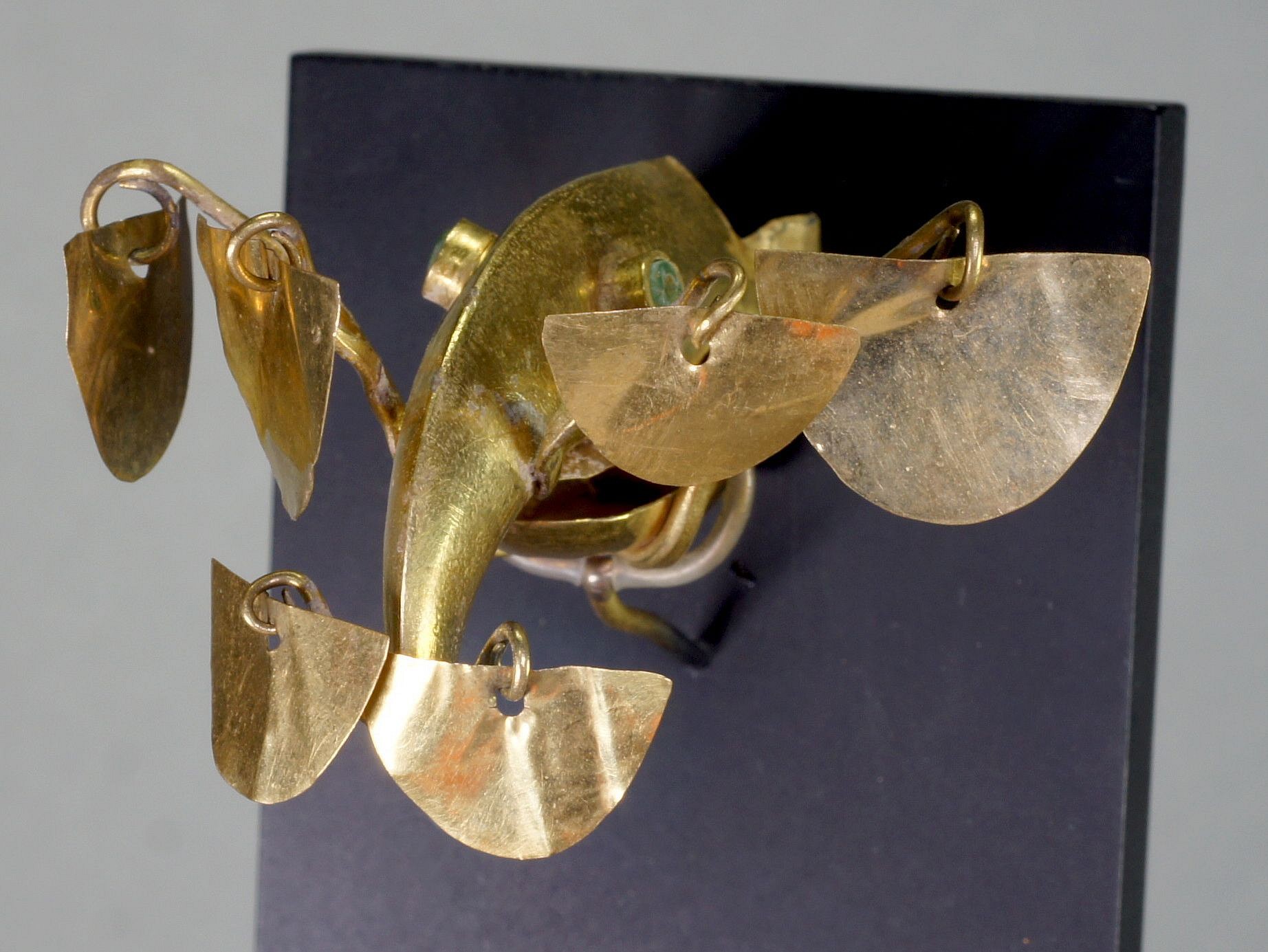



Peru, Early Moche/Vicus Head of a Tucan with Dangles
This object is quite rare and is from Northern Peru, by the Maranon river valley where other Vicus style objects have come from. It is fashioned from a heavy sheet, bent, soldered, and has dangles. It would have fit front and center onto a headdress, attached using the tabs at the back. The rods that hold the dangles are soldered, along with the bottom of the beak. The eyes are soldered rings with turquoise inlays. A similar object is illustrated in the GOLD OF PERU, Mujica Gaillo collection.
Period: Peru, Vicus, Far North Coast, c. 300 BC - AD 300
Media: Metal
Dimensions: Length 3 3/4" Weight 32.8 grams
$8,500
91055
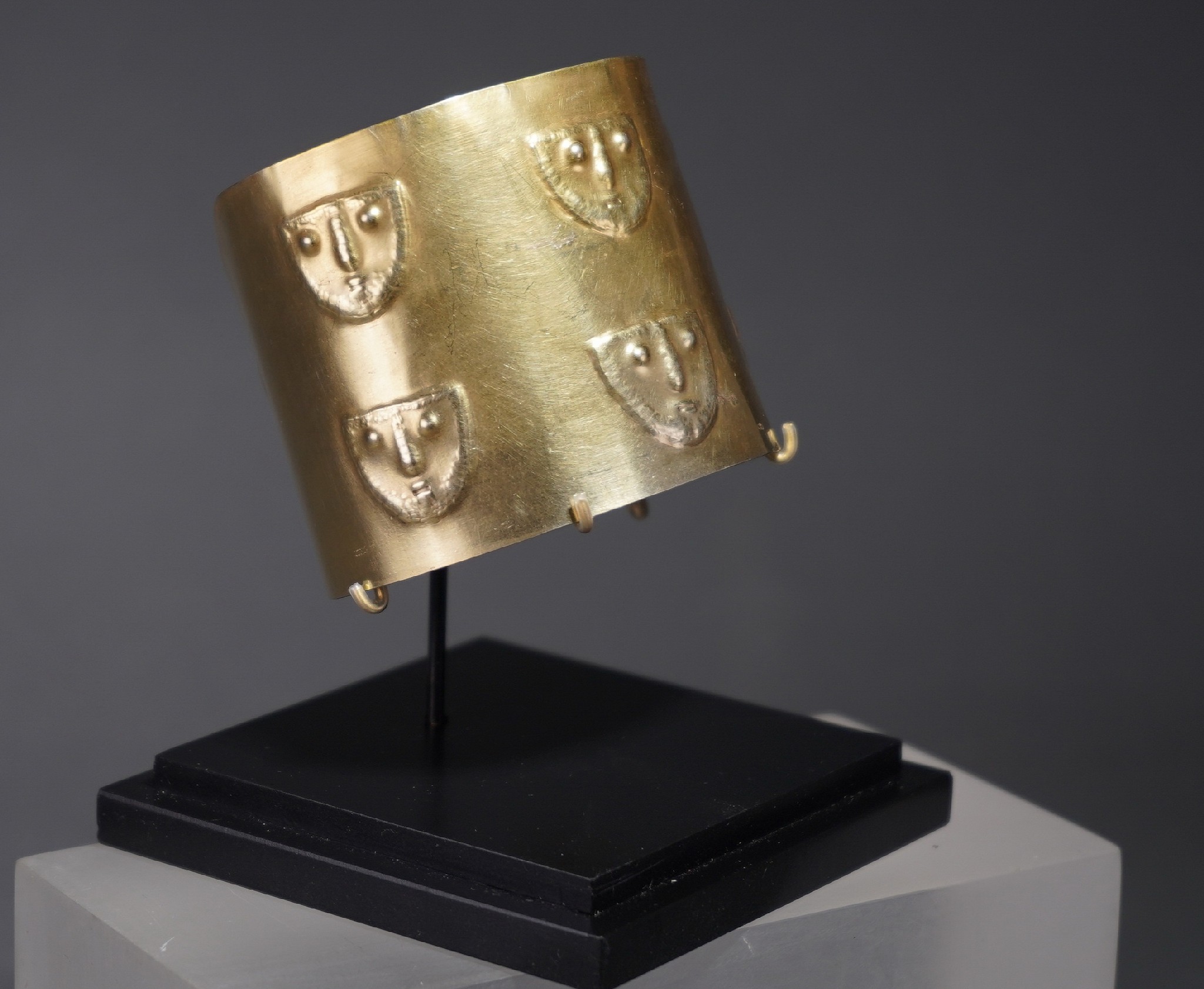





Peru, Late Nasca Gold Cuff with Embossed Faces
A hammered and repousse gold cuff decorated with two rows of faces, probably representing masks. I have not seen many cuffs embossed, as most Late Nasca art consists of simple wrought gold, occasionally with a geometric pattern. These embossed masks are quite rare. There are two tie holes on each edge of the cuff. Similar Nasca gold cuffs are illustrated in the THE GOLD OF PERU, MUJICA GAILLO COLLECTION. Ex-Collection Jean Eugene Lions, St. Tropez, since 1970.
Period: Peru, Nasca, South Coast, c. AD 400 - 800
Media: Metal
Dimensions: Height 2 1/4' Weight 40 grams
Alloy: Au.32.7, Ag. 55.3 & Cu.11.6 = 99.6%
$6,750
M5078




Peru, Wari Embossed Gold Feather Plume Decoration Depicting a Pair of Vultures
This double-headed design features two cutout birds of prey holding serpents in their beaks. This style of gold plume would have been attached to the headdress of a high-status individual, signifying strength and power. A less elaborate gold plum by the same artist is illustrated in WARI: Lords of the Ancient Andes, page 227. Acquired from a New York collector prior to 1990.
Period: Peru, Wari, Central Coast, c. AD 650 - 1100
Media: Metal
Dimensions: Height 11 1/4" Weight: 26 grams.
Price Upon Request
m7122
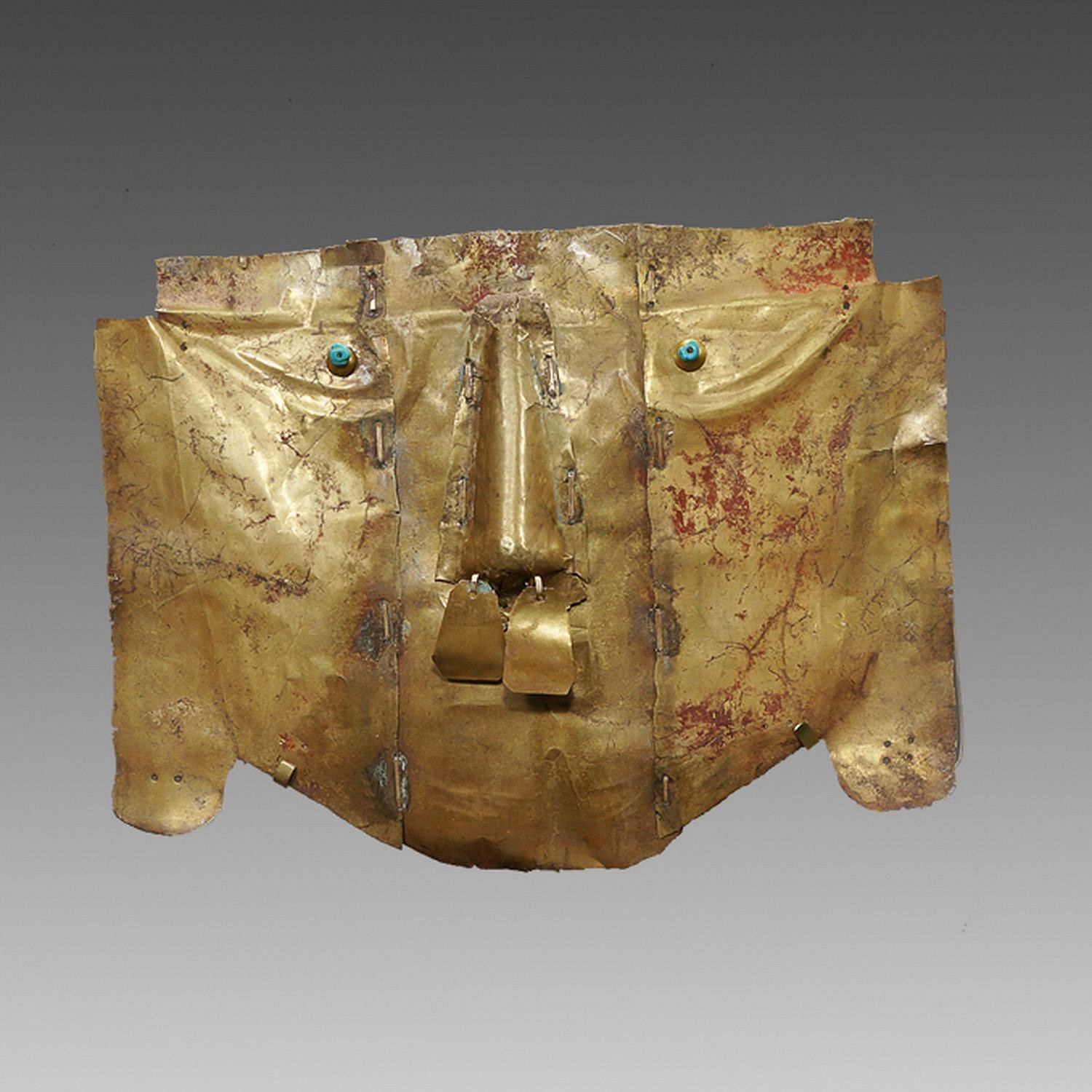
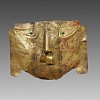




Peru, Sican Gold Mask of the Third Type
A classic type of mask from the 3rd Phase, constructed in 3 parts and held together by ancient gold staples. The eyes have turquoise bead pupils with gold hemispheres. Traces of the original cinnabar remain. Sicán masks are discussed in THE ART OF PRECOLUMBIAN GOLD - The Jan Mitchell Collection, page 66 - see example(s). The Sicán culture was extremely wealthy and was known to have built the largest city in the Americas, Chan- Chan, outside of the modern city of Trujillo. The Sicán were excellent gold workers, and when the Incas conquered them, they brought the metalsmiths to the Inca capital of Cuzco. Similar masks are illustrated in THE GOLD OF PERU-MUJICA GAILLO Collection. Ex. Private New York Collector.
Period: Peru, Sican, c. AD 800 - 1100
Media: Metal
Dimensions: Height: 7.75" x Width 10 1/8"
Price Upon Request
n4001
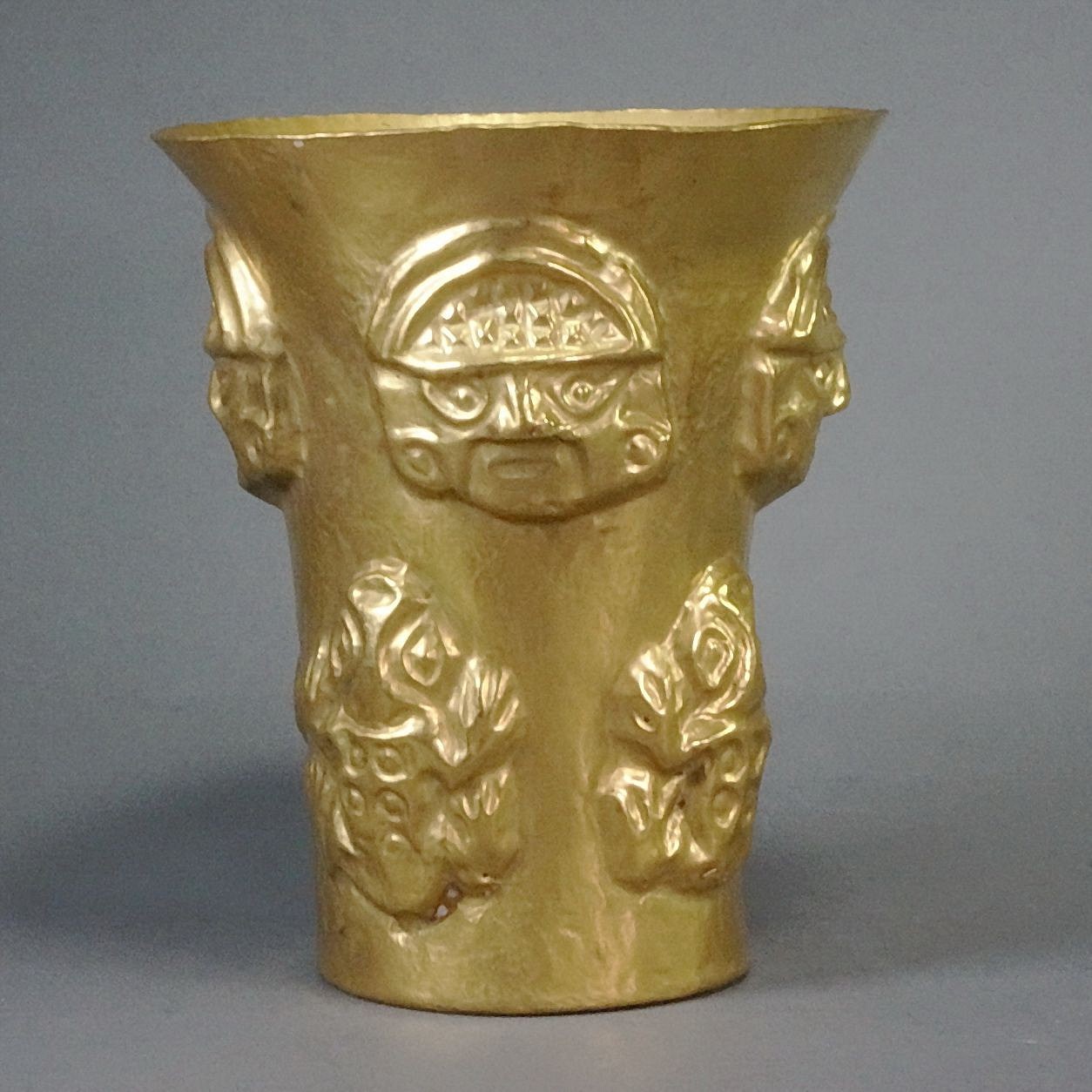
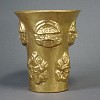




Peru, Sican Gold Beaker with Mask and Frog Motif
The Sican cache of gold came from the largest burial in the Americas at hacienda Batan Grande near the Chimu City of Chan Chan. These beakers were used to drink the ceremonial Chicha (Corn Beer). The masks and flared beakers were the most notable objects from this burial. The beakers came in various designs from frogs to Warriors. This beaker is unusual in that it has both masks and frog motifs. Illustrated in THE ART OF PRECOLUMBIAN GOLD, pg.227 the on the right. Exhibited in 1964, Los Angles # 202. Ex-Jan Mitchell collection, prior to 1980.
Period: Peru, Sican, Batan Grande (Upper Leche River Valley), North Coast, c. AD 850 - 1150
Media: Metal
Dimensions: Height: 5. 1/8" Diameter at top: 4 3/8" Weight: 184 grams
Price Upon Request
n7054



Peru, Chimu Gold Cuff with Three Bands of 4 Repousse Stars Each
This gold cuff would have been worn as an adornment by a high-status male warrior. It features three rows of repousse starts, with four stars in each row, and two tie holes. A cuff with a similar star design is illustrated in the catalog of the Gold Museum of Peru on page 127. Formerly in the collection of Camilla Deitz Bergeron, New York antiquaire, acquired prior to the 1980s.
Period: Peru, Chimu, Early Phase, North Coast, c. AD 900 - 1100
Media: Metal
Dimensions: Height 4 1/2" Weight: 65.5 grams.
$9,500
N2064
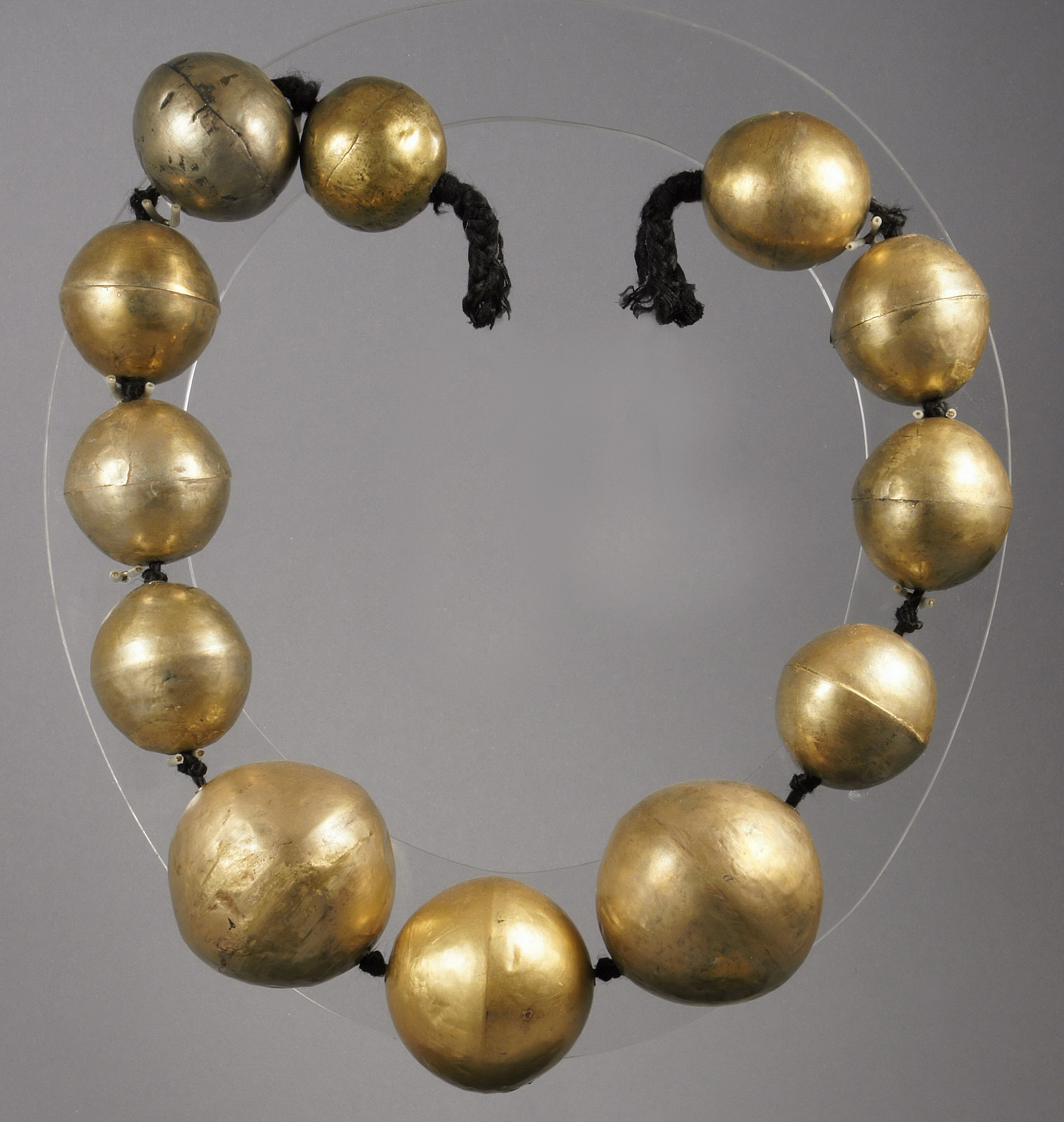

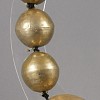
Peru, Chimú Gold 29" Necklace of Large Hollow Beads
The Chimú inherited a taste for hollow gold bead necklaces from their Moche predecessors. In both cultures, each bead was cast and hammered in two halves that were then joined together by soldering. In the Chimú technique, the edges of the two halves were nested together. These beads are extremely light with a greater percentage of silver than gold. They used depletion gilding to bring the gold to the surface by using of heats and salts. This allowed the Chimu to make the gold available for a large and growing ruling class. Private Florida collection prior to 1980.
Period: Peru, Chimu, North Coast, c. AD 900 - 1350
Media: Metal
Dimensions: Necklace Length: 29"; largest bead 2 1/4" diameter - smallest 1 1/2"
$27,000
M7991
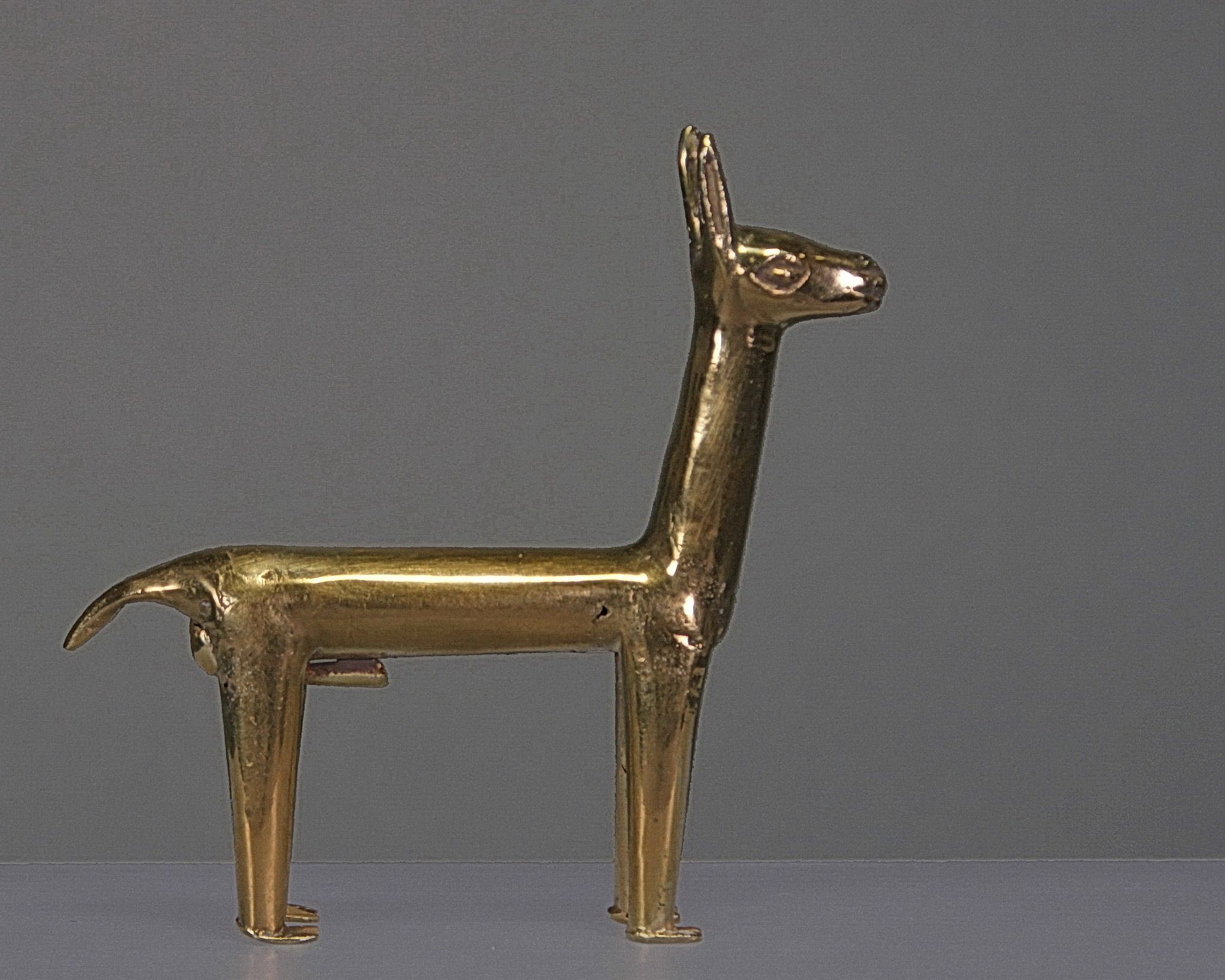




Peru, Inca Gold Hollow Llama
These Llamas, along with other miniatures in gold, silver and spondylus were found at high altitude sacrificial burials sites, used in a ceremony known as the Capac Hucha ceremony to praise the Inca. A similar llama is illustrated in ANCIENT AMERICANS, Art From Sacred Landscapes p. 362. This hollow llama was assembled from hammered gold sheets which were soldered together. One seam can be easily seen along the underside. Ex. New York collector, prior to 1970.
Period: Peru, Inca, Early Phase, South Highlands, c. AD 650 - 1250
Media: Metal
Dimensions: Height: 2.5" Weight: grams 9.6
XRF: Au. 66.4%, Ag. 24.6% , Cu8.8%
Price Upon Request
n7053
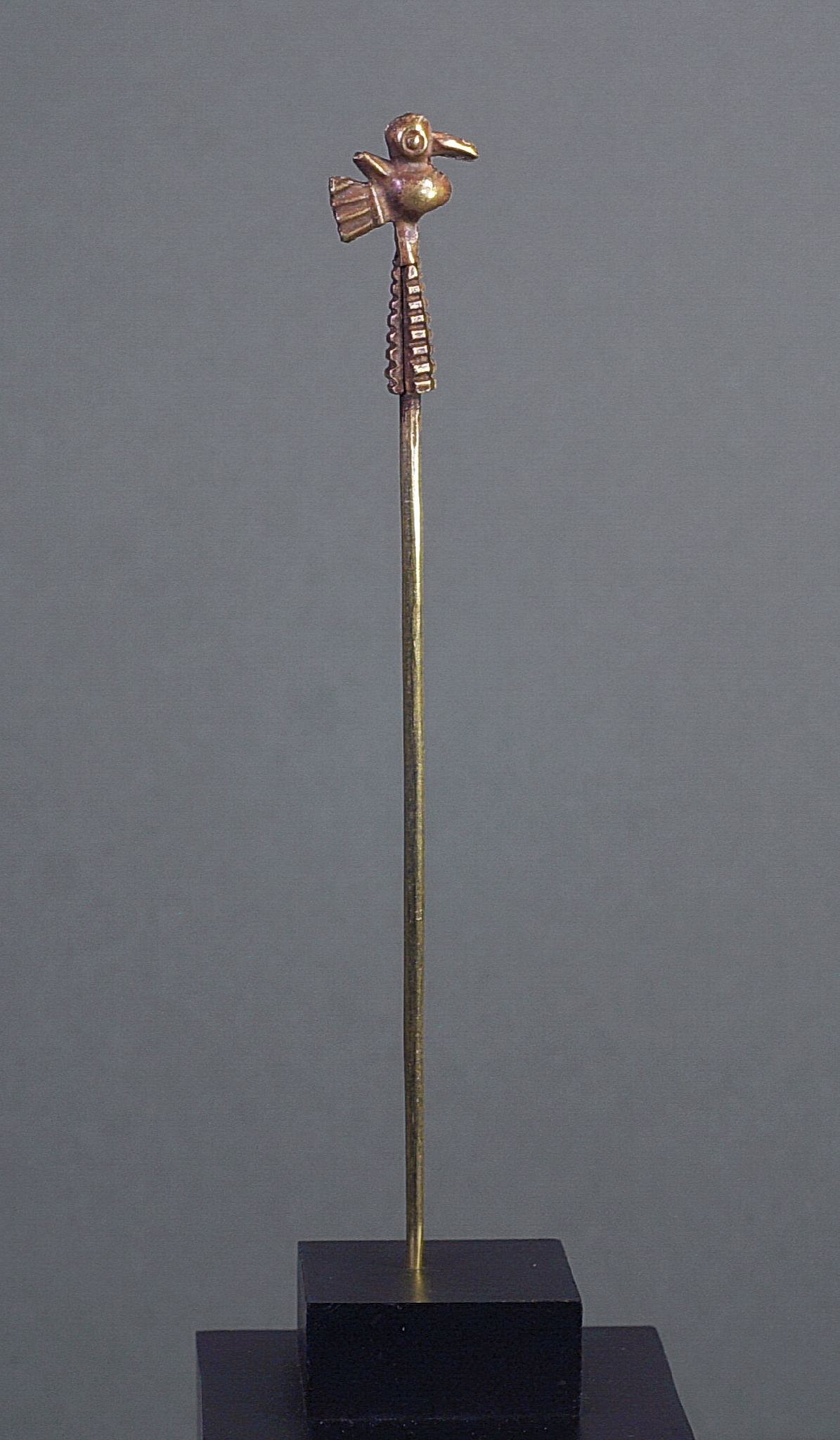





Peru, Inca Gold Fastening Pin Topped with Bird Perched on Corn Cob
Gold works of art from the Inca period is rare, as most Inca gold was confiscated and melted down by the Conquistadores during colonization. This apparently simple cast pin is quite complicated in its manufacture. The pin and the corn cob were cast, whereas the bird is made of a separate stamped sheet - designed head-to-head, bent, and soldered to itself. The bird was then fitted over the top to create the appearance of a single cast object. A similar piece appears in Kunst Und Kultur von Peru (Art and Culture of Peru) by Max Schmidt, page 396. From a private Florida collection, acquired prior to 1980.
Period: Peru, Chimu, North Coast, c. AD 900 - 1350
Media: Metal
Dimensions: Length: 5" Weight: 4.7 grams.
$1,950
MM625
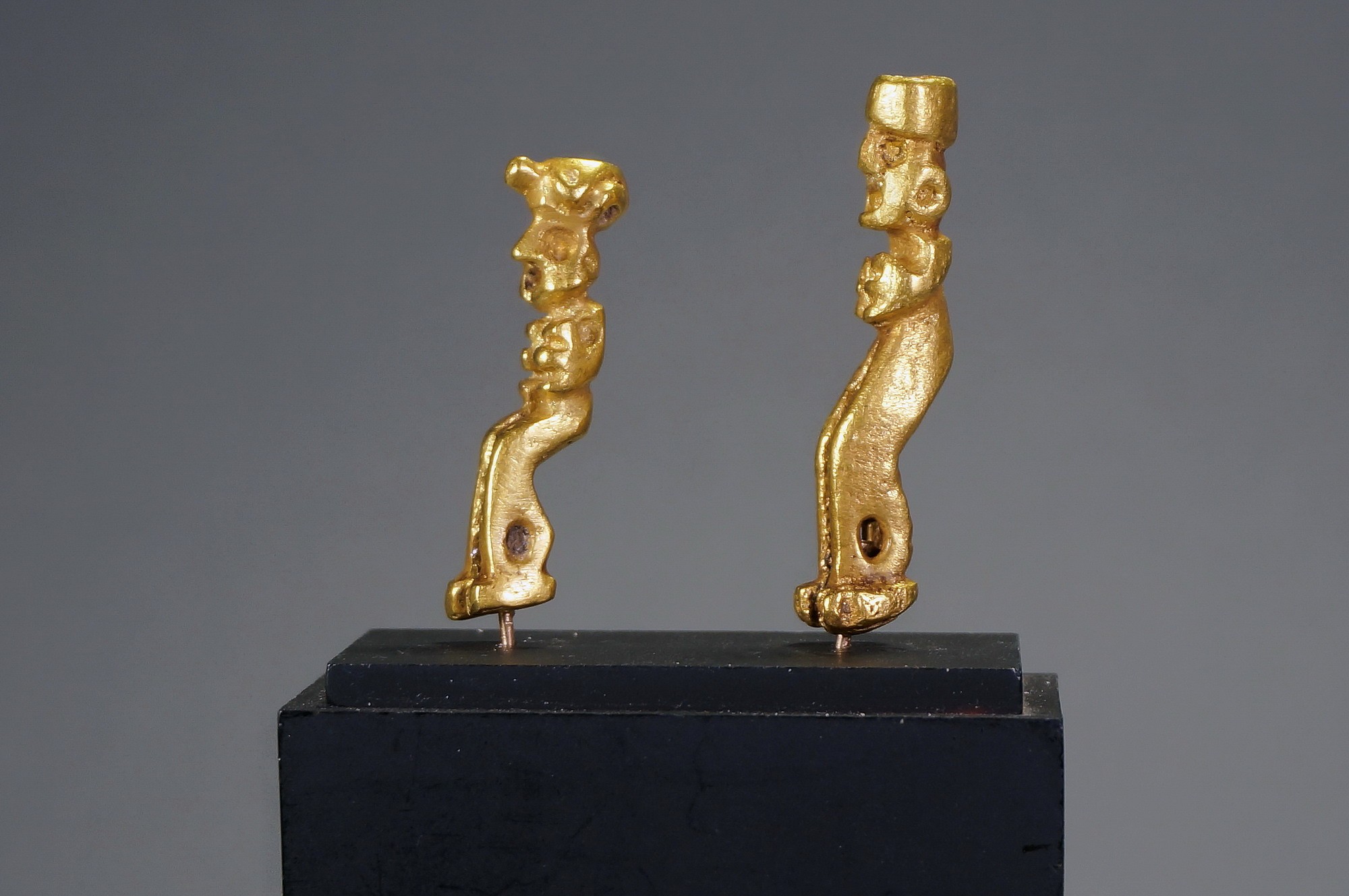




Peru, Two Inca Miniature Cast Gold Standing Figures
These two solid cast gold figures are highly unusual subjects. Each figure has exaggerated hands and elongated legs. Both figures have cast suspension holes above the ankles. The top of each figure has a hollow shape that could have been used to insert feathers. The only other example illustrated is in Oro del Antiguo Peru, lamina 210 (7 cm or 2.75"). One figure is wearing a headdress with a feline motif and the other one with a simple cylindrical shape. Ex. New York collector, prior to 1970.
Period: Peru, Inca, c. AD 1400 - 1532
Media: Metal
Dimensions: Height:1.5" and 1.75"; Weight: 24 grams for pair.
Price Upon Request
n7028
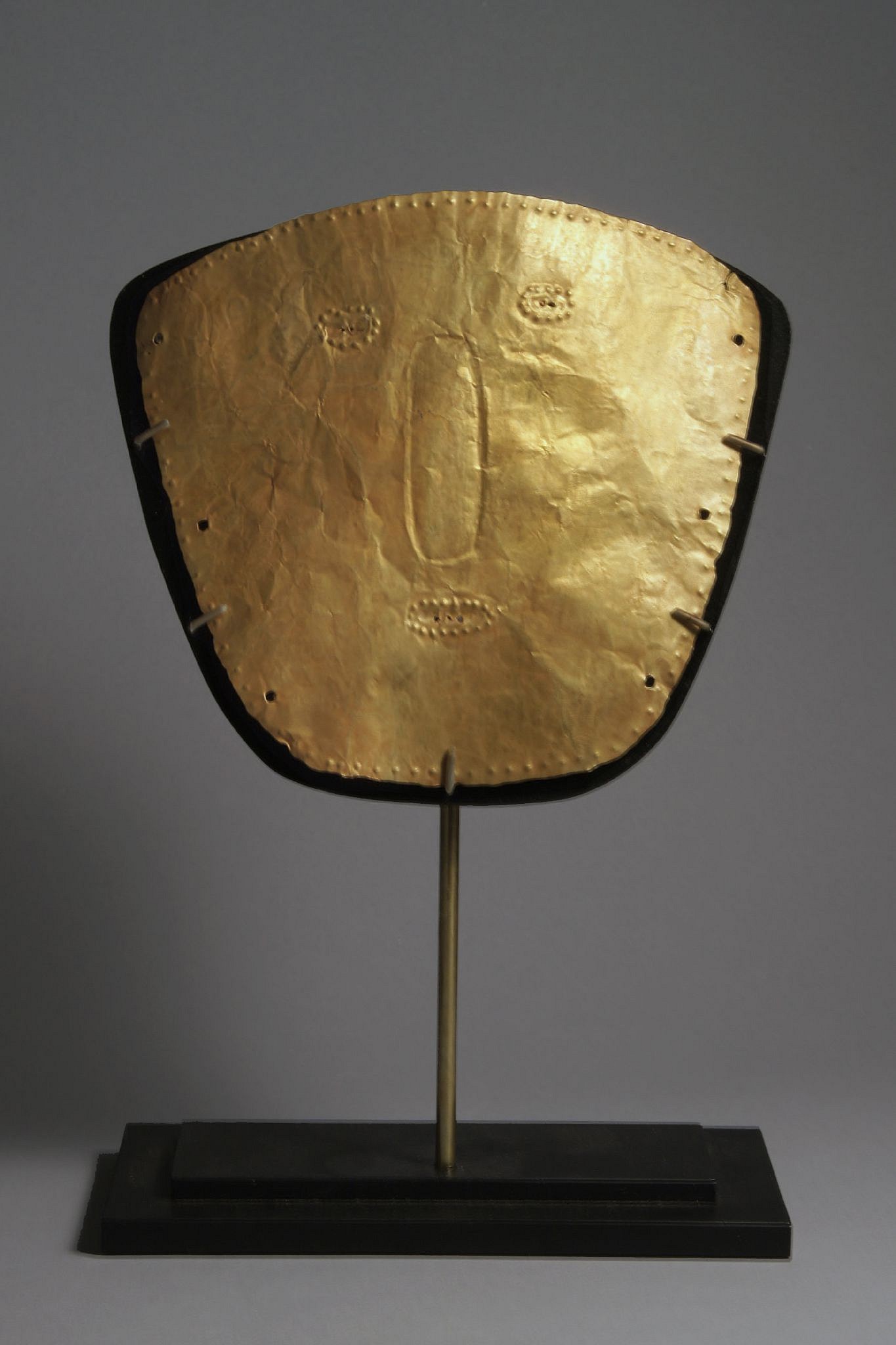

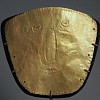

Chile, Diaguita Style Gold Mask with Repoussé Eyes, Mouth and Border
The eyes and mouth have pierced holes to attach turquoise eyes and a shell mouth. The six holes on the side of the mask were for tying the mask to the mummy. There are very few gold masks found in Chile because partly because that there was little gold available from rivers. The little-known gold that has been found in Chile was probably traded with Bolivia or even Peru. This mask is one of three that were supposedly found in Northern Chile near Arica. Very few masks from Arica are known as the area was poor and gold had to have been imported. The tradition of these simple masks goes back to the Chinchorro culture (circa 7,000 BC) of Northern Chile. I have found one gold diadem now in the American Museum of Natural History in New York which has a similar nose design. It is safe to say that this mask most closely resembles the same facial designs on the Diaguita ceramics from La Serenna - the round eyes, straight vertical nose and the horizontal mouth. The repousse design around the edge relates to the painted spots on the ceramic face. With this mask came a gold headband or turban, measuring 36" x 3/8" in width. The headband has the same repousse design on the edges. The gold content was tested at 17KT. and has been annealed and burnished to a thickness of 1/128"
Period: Chile, Diaguita Culture, Northern region, c. AD 1200 - 1470
Media: Metal
Dimensions: Width 6" x Height 5 1/4" Weight: 4.6 grams
XRF Au.69%, Ag.26% Cu. 4%
Price Upon Request
M7166







Ecuador, 7 La Tolita Gold with Platinum Miniature Ear Ornaments with Turquoise Inlays
Each ornament has an inlayed turquoise stone and a suspension ring. These are excellent examples of early granulation and sintering techniques. Sintering is the process of melting gold foil over platinum which can then be reheated and annealed to fashion small objects. Similar ear ornaments are published in The Gold of Eldorado, by Warwick Bray and in Charms in Pre-Columbian Ecuador by Christian Mesia Montenegro. Acquired in 1994 from an old estate auction.
Period: Ecuador, La Tolita, c. 1500 BC
Media: Metal
Dimensions: Approx. Length: 1" each. Weight: 4 grams.
$4,600
94203

Ecuador, Three Tolita Gold Nose Ornaments
Three gold U-shaped miniature nose ornaments, each with a different pattern of granulation. The U-shape would likely have been created using lost wax casting and then granulated. Granulation uses heat only to attach the small spheres to the cast. A similar piece is illustrated in Charms in Pre-Columbian Ecuador by Christian Mesia Montenegro, 2007, on pages 53 and 55.
Period: Ecuador, La Tolita, c. 1500 - 400 BC
Media: Metal
Dimensions: Diameter: 7/8 - 2 3/8 inches. Weight:12.2 grams.
$4,500
99128
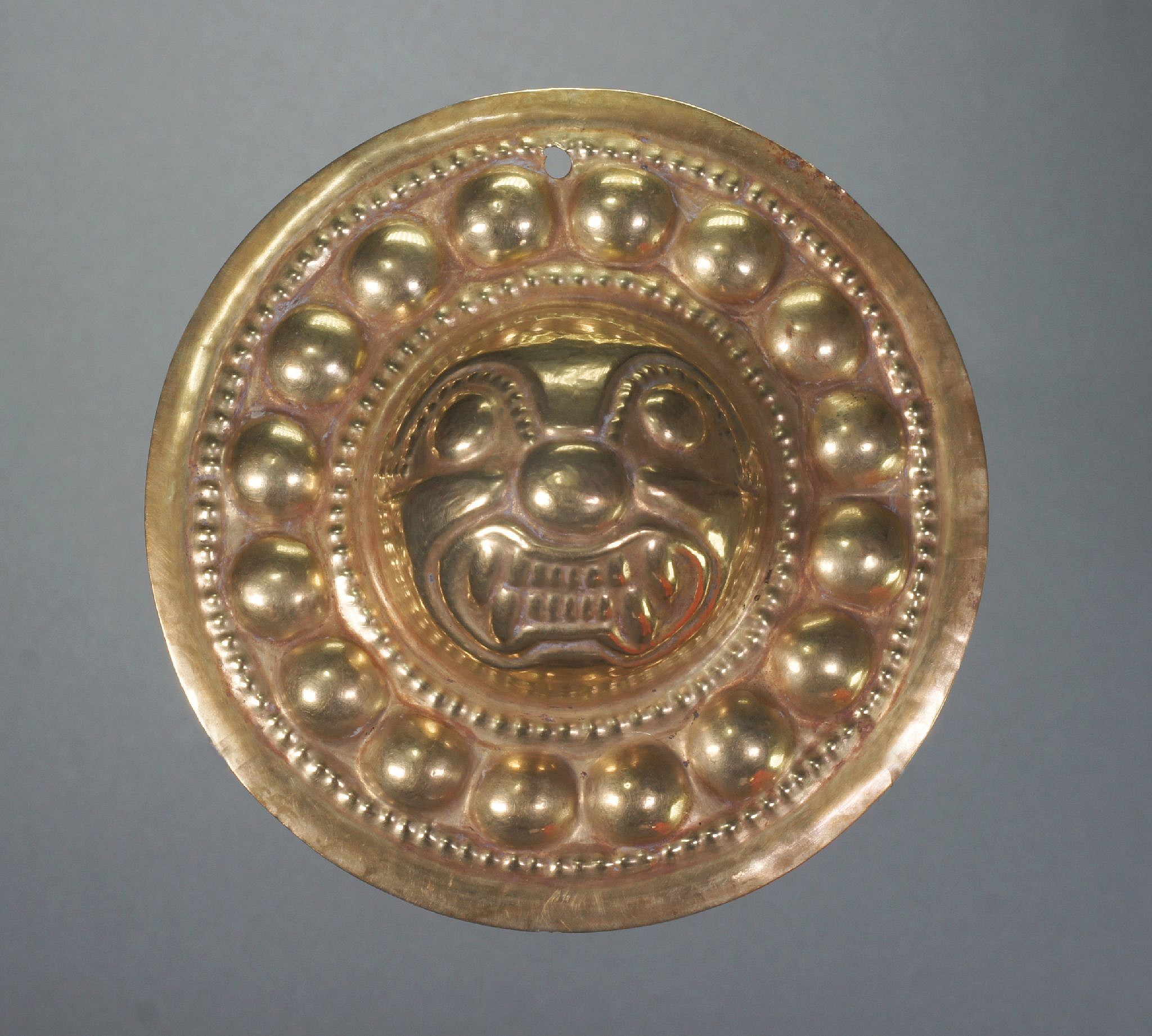





Ecuador, Narino Gold Embossed Ornament Decorated with a Feline Head
These ornaments have a suspension on the rim and were either ear ornaments or pendants. The designs vary, from concentric circles to heads in high relief, ranging from human to animal faces. The feline face is the largest of the head types. Similar examples are illustrated in El Dorado by Warwick Bray, p.213. Ex. New York collector, prior to 1970.
Period: Ecuador, Narino, Capuli, Southwest, c. AD 700 - 1500
Media: Metal
Dimensions: Diameter: 3.9" Weight: 26.7grams
Gold alloy: Gold 73.4%, Silver 17.9%, Copper 8.3% and Sn. Tin .01%
Price Upon Request
N7060
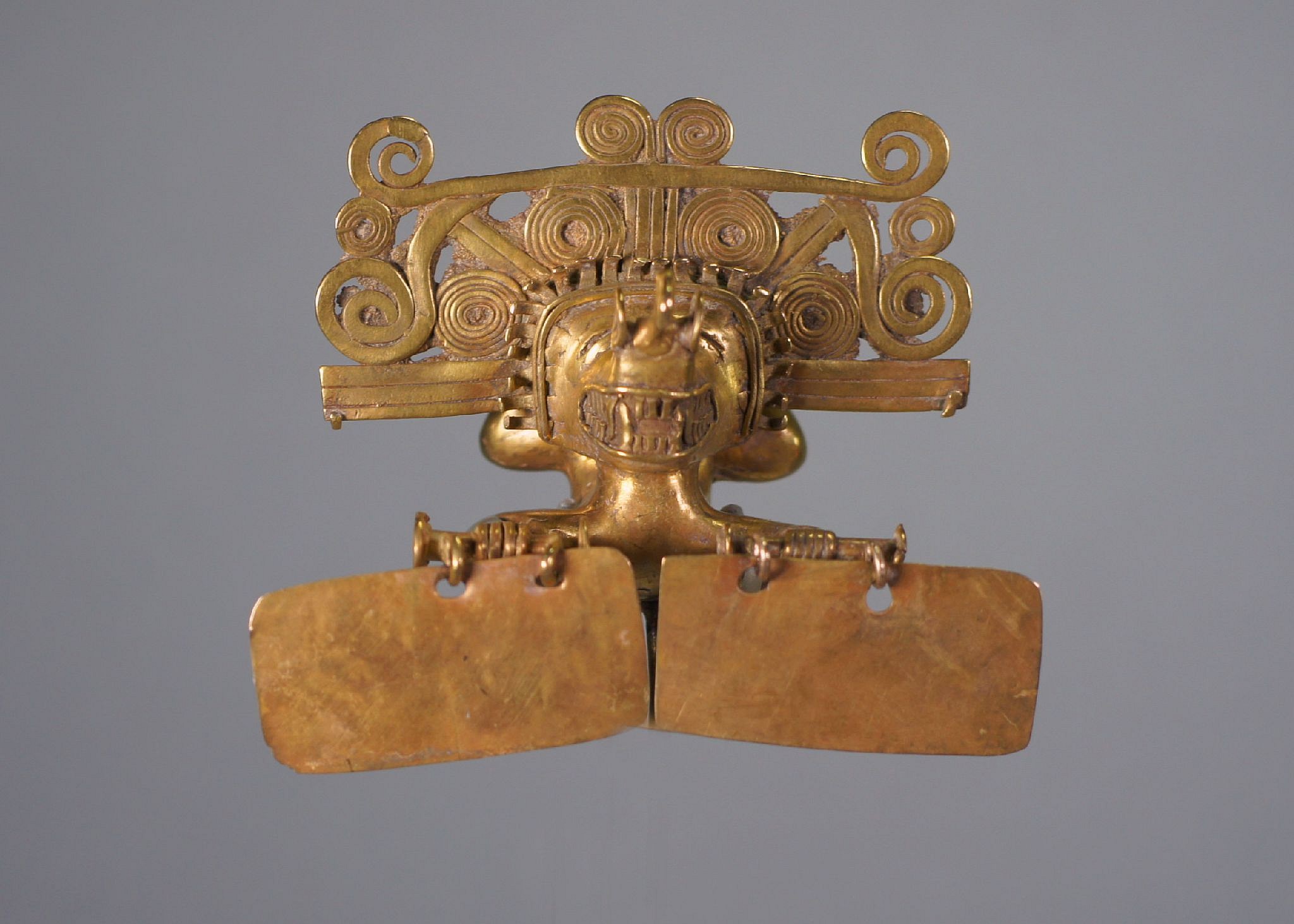


Colombia, Quimbaya Style Gold Pendant of a Tumbling Shaman with Two Rectangular Dangles
Cast figural pendant of a feline-headed Shaman tumbling in a trance. The shaman holds bars with large rectangles in each hand. This pendant is extremely well sculpted with curved limbs arching upward at the back, legs bent, and toes curled, with suspension loops on each sole. This example was purported to be found in the Uruba region of North West Colombia. The subject is a very rare subject for Colombian gold work.
Period: Colombia, Gulf of Uruba, c. AD 500 - 1000
Media: Metal
Dimensions: Width: 2 5/8 inches
Price Upon Request
99120
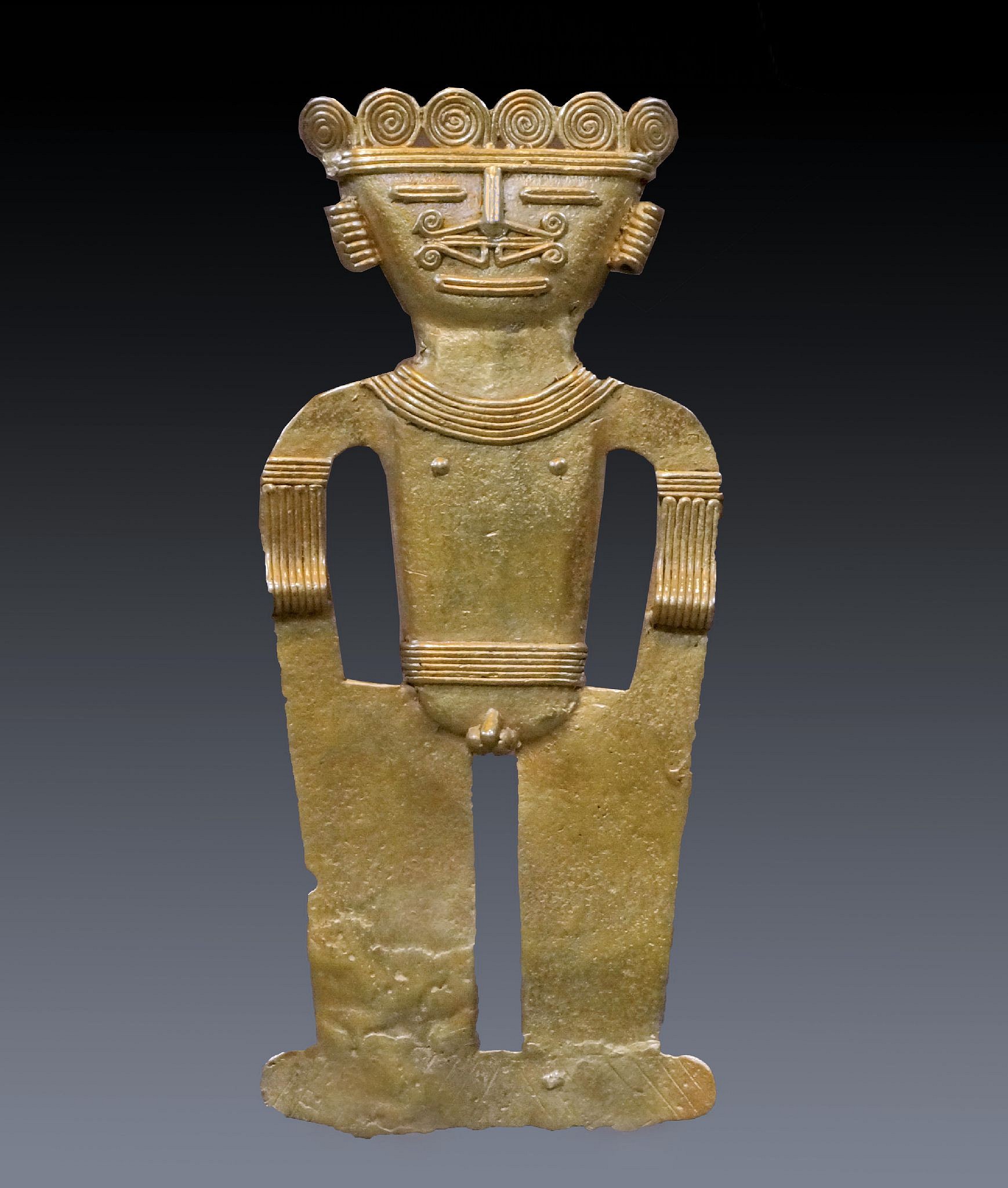



Colombia, Quimbaya cast gold pendant of a Lord in a Trance
The personage is wearing a crown, elaborate nose ornament, and necklace. He has an ancient casting repair to the lower left knee. The Uruba region is located on the Colombian/Panamanian border and had received early influences from the Quimbaya people and later influences from the Sinu. A similar pendant is illustrated in the article THE DARIEN GOLD PENDANTS OF ANCIENT COLOMBIA AND THE ISTHMUS, figure 35, and in the catalog of the Banco de Oro de Colombia # 414, Lam 46.
Period: Colombia, Gulf of Uruba, c. AD 500 - 1000
Media: Metal
Dimensions: Height: 6 3/8" ( 16.3cm) Weight 91.4 grams
XRF Au. 62% Ag. 22%, Cu16%
Price Upon Request
n4033
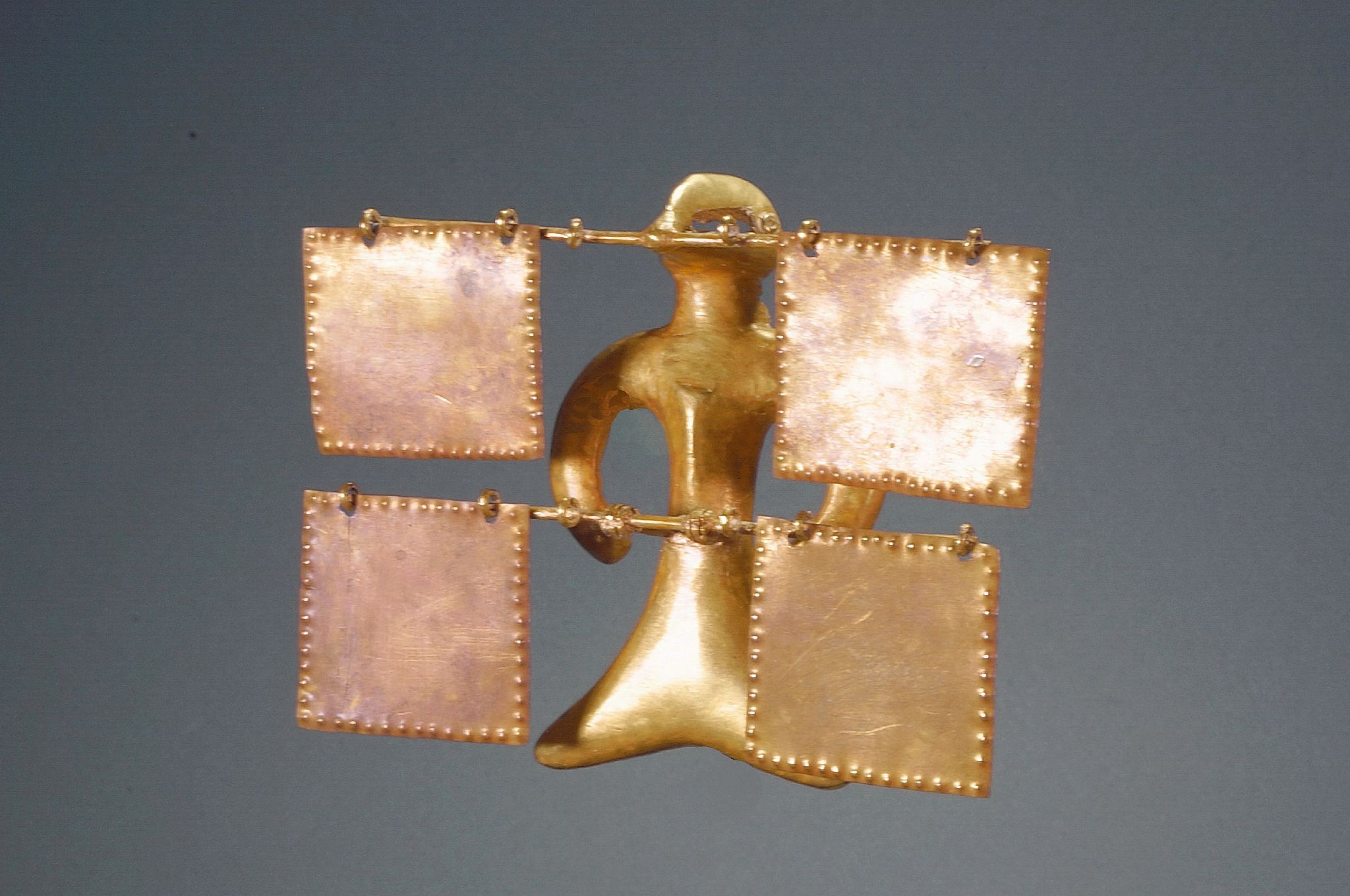



Colombia, Uruba Style Bird Pendant with Square Plaque Dangles
The bird has its wings arched to its sides, a flared tail, and four dangles suspended on two bars. The small suspension holes are inside the back of the neck. The bird has bead-like eyes and is a generalized composite of various birds. This piece is well cast, with evidence of the carbon core intact. There is a similar bird in The Gold Museum of Colombia in Bogota. Ex. Louisiana professor acquired prior to 1980s'.
Period: Colombia, Gulf of Uruba, c. AD 500 - 1000
Media: Metal
Dimensions: Height: 3 1/2" x Width: 4 1/2" Weight 33.6 grams.
$12,500
MM068
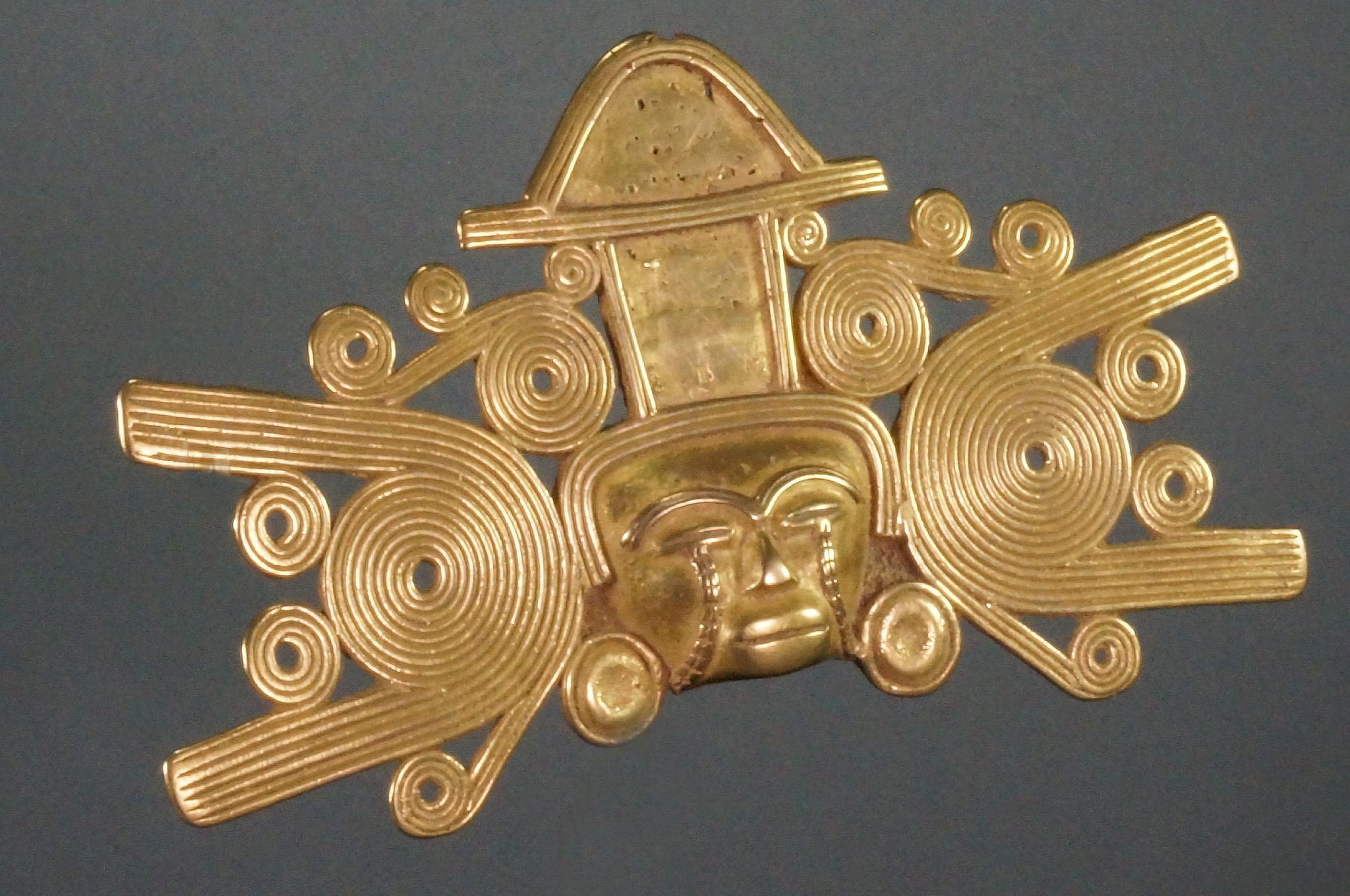



Colombia, Quimbaya Cast Gold Pendant of a Lord
The deity is in a trance with tears coming down from his eyes. It was created using the lost wax cast technique without any flaws. It is illustrated in "Guide to the Arts of the Americas" by Harmer Johnson and Peter Furst, pg. 112-B. This is a unique subject and was found in the Uruba region of Northwestern Columbia with the border of Panama. This region is known to have gold styles from Quimbaya, Sinu and Darian and must have been a center of trade. Examined by Robert Sonin for authenticity. Acquired from a New York collector in 1998.
Period: Colombia, Quimbaya, Cauca River Valley, c. AD 400 - 800
Media: Metal
Dimensions: Height 3 1/2" x Width 5" Weight: 81.4 grams
Price Upon Request
M7990






Colombia, Calima Gold Tupu (Lime Dipper) of a Deity Seated on a Serpent
The deity has an elaborate face mask and holds the tail of the serpent upon which he is seated. This is a known motif, but rarely seen with a human, as most are found with a cayman or feline as the primary figure. According to the research, only limited types of images were used for lime dippers, usually shamans or warriors. A similar example is illustrated in Calima and Malagana, by Marianne Cardale Schrimpff, page 116, plate 111.37.
Period: Colombia, Calima, Yotoco Phase, Cauca River Valley, c. AD 100 - 1000
Media: Metal
Dimensions: Length:5 1/4 " x Weight: 34 grams.
$8,250
M8031





Colombia, Calima Cast Gold Lime Dipper of a Warrior with Animal Perched on Back
This finely cast gold lime dipper features a warrior with an animal perched on his back and a tapering shaft terminating in two bands of granulation. The warrior wears an elaborate mask, a curving headdress, and holds a staff with both hands. Gold lime dippers often featured warrior figures and were reserved for important personages. For further reading, see Calima and Malagana, by Marianne Cardale Schrimpff. A similar lime spoon is illustrated on p. 115, plate 111.34. This is an excellent example of lost wax casting. Acquired in 2000 from private New York collector.
Period: Colombia, International style, AD 700 - 1000
Media: Metal
Dimensions: Length:(8 1/4" Weight 15.9 grams.
$12,000
MM618




Colombia, Early Calima Gold Lime Dipper
A fine lost wax cast lime dipper with a mythological monkey deity on the tip. The monkey wears a helmet, ear spools, and an elaborate headdress which falls down the back of his body. Lime dippers were used to mix lime with crushed leaves from the Erythroxylum coca plant (from which cocaine is derived) to create a drug compound that functioned as a psychoactive stimulant used in ritual ceremonies. According to the research, only limited types of imagery was used for lime dippers, usually shamans or warriors. See Calima and Malagana, by Marianne Cardale Schrimpff for further reading. A similar but not exact motif is also illustrated in Orfebreria Prehispanica de Colombia on page 84, plate # 5232.
Period: Colombia, Calima, Yotoco Phase, Cauca River Valley, c. AD 100 - 1000
Media: Metal
Dimensions: Length: 8 1/2" Weight: 25 grams.
$9,500
97146
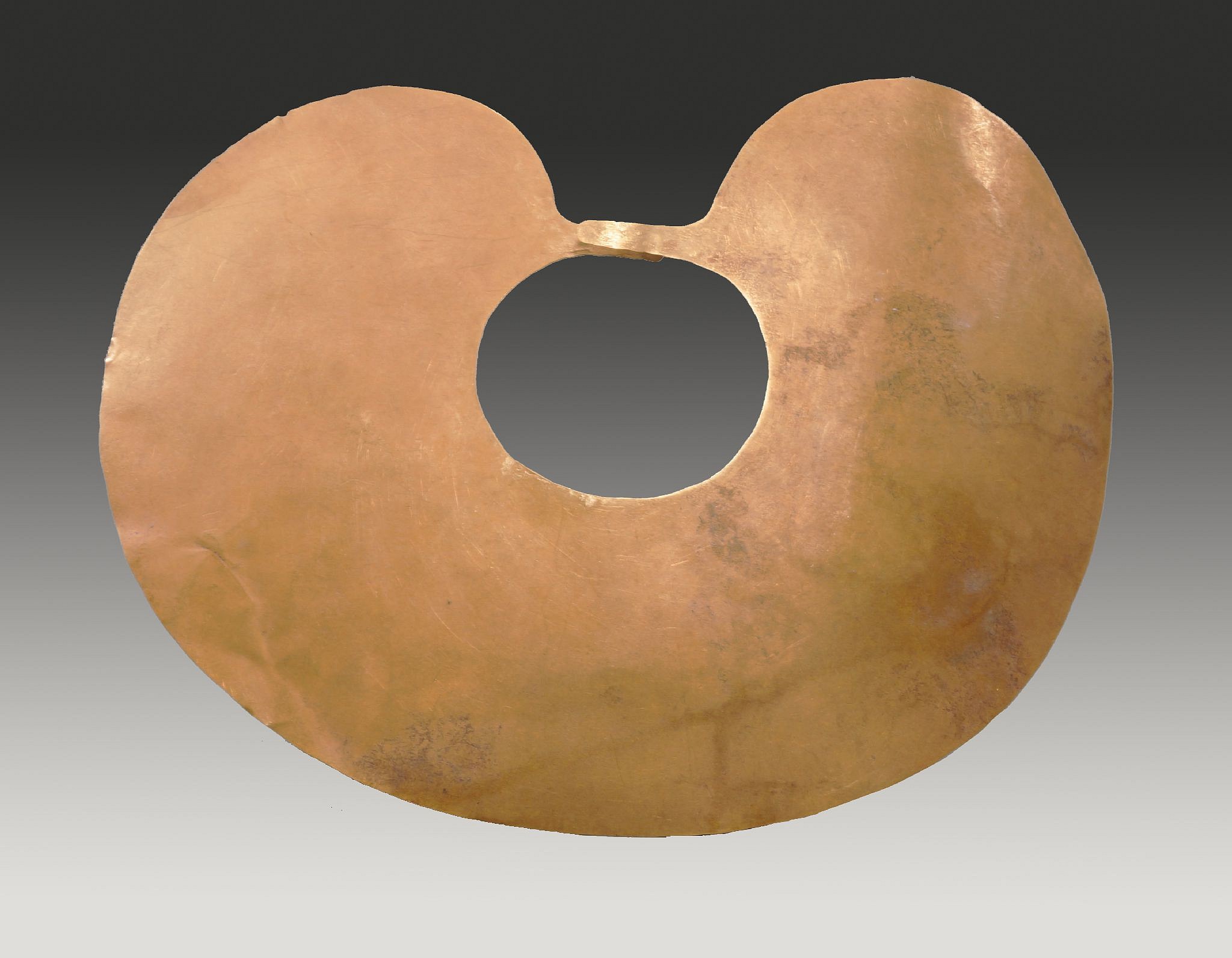
Colombia, Calima Gold Kidney Shaped Nose Ornament with Satin Finish
This is an early example of Calima gold working displaying a high degree skill of annealing to create an even thickness. The Kidney shape is continued during the entire Calima presence and becomes more elaborate with time.
Period: Panama, Conte Style, c. AD 600 - 800
Media: Metal
Dimensions: Height: 6 1/2" x Width: 7 7/8" Weight: 53 grams
Price Upon Request
97228
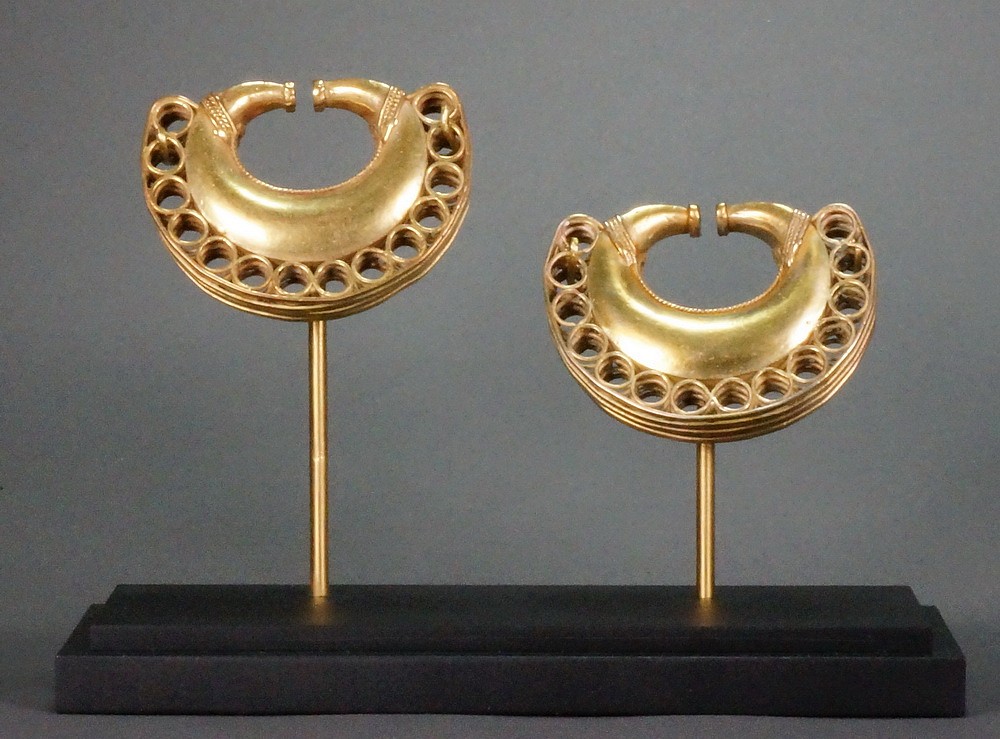




Colombia, Tairona Pair of gold lost wax cast ear ornaments decorated with braidwork
This is a particularly strong and heavy pair of matched ear ornaments from the Tairona people who were known for their fine casting work. A very similar pair is illustrated in THE GOLD OF ELDORADO by Warick Bray pg. 164.
Period: Colombia, Tairona, c. AD 1000 - 1500
Media: Metal
Dimensions: Width: 2 3/4" x Height: 2" Weight: 48.4 & 49.6 grams
XRF: Au. 49.1%, Ag. 7.6%, Cu. 42%
Price Upon Request
n8012
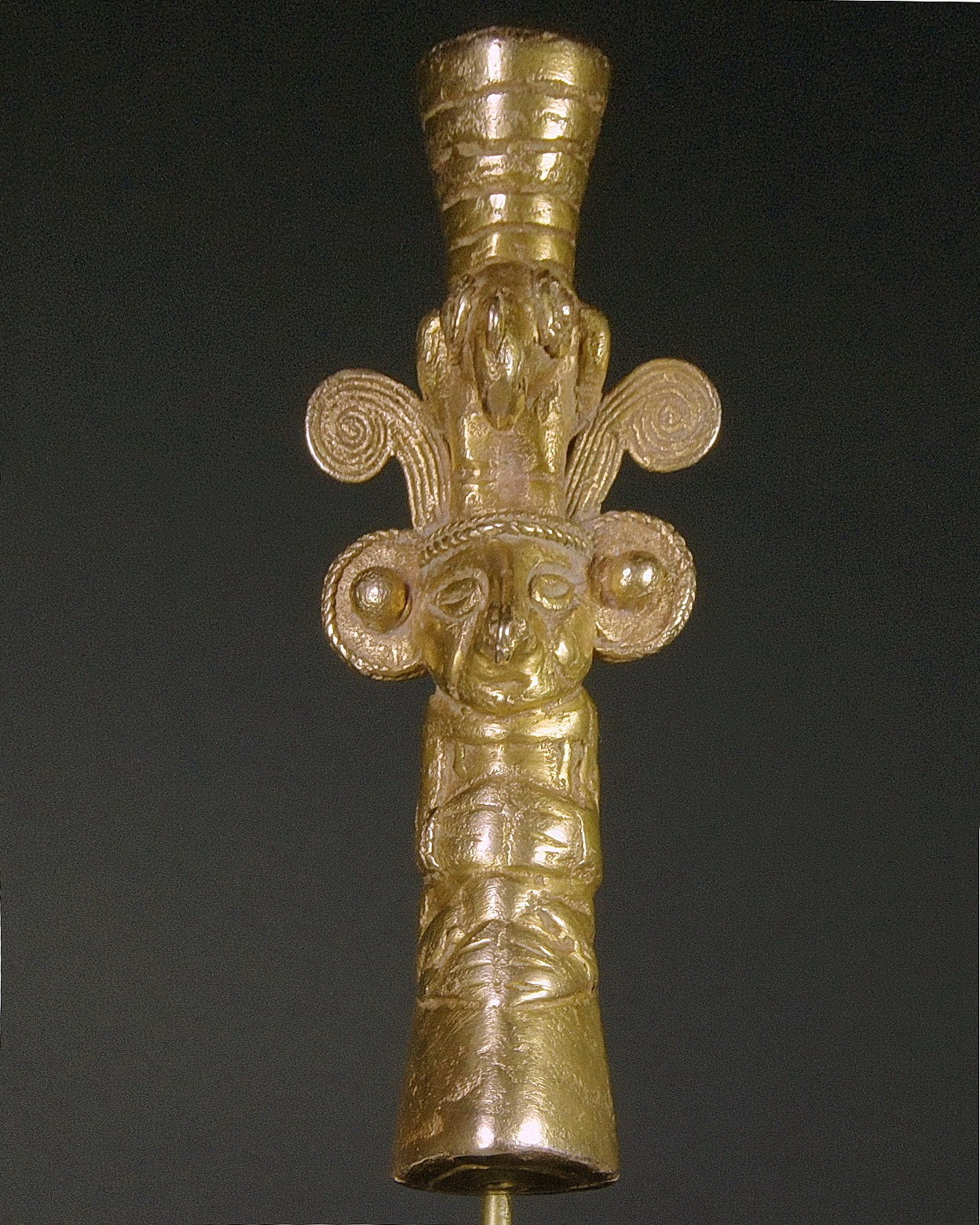



Colombia, Sinu Cast Gold Whistle with a Condor Standing On Top of a Shaman
This is a large example of a Sinu golden whistle which is lost wax cast in the round. Its subject is very unusual with a Condor standing on top of a Shaman who is in transition from a personage into an animal with large feet and hands. There are two suspension loops cast on the back which show signs of wear. There are loops on both the noses, which once had gold discs dangling which were lost. There are a few known whistles in the literature but none with this totem like subject.
Period: Colombia, Sinu, Santa Marta, c. AD 700 - 1500
Media: Metal
Dimensions: Height: 4 1/2" Weight 91.5 grams
XRF Au.58%, Cu. #0%, Ag, 10%
Price Upon Request
N6005
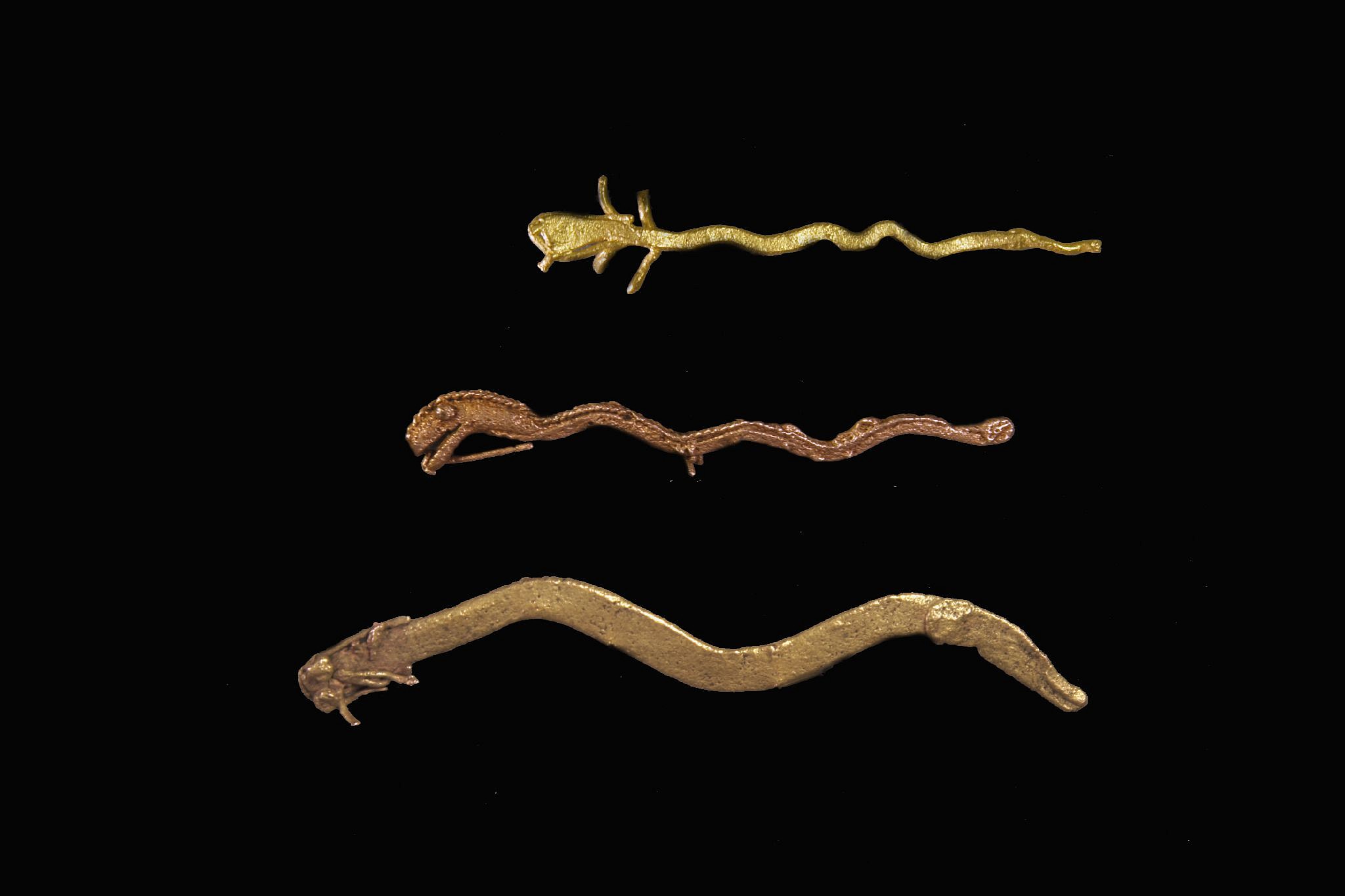


Colombia, 3 Muisca Cast Gold Snakes
The Muisca people of Eastern Columbia were known for their famous myth, El Dorado. El Dorado refers to a lord riding on a golden raft and covered in gold dust. Serpents are featured prominently in the Muisca creation myth, which describes two snakes emerging from the Iguaque lagoon as a women and child. Transmutation was an important theme to the Musica; these snakes are all cast using the lost wax technique as well as the manipulation of alloys to create the three different hues of gold.
Period: Colombia, Muisca, c. AD 700 - 1500
Media: Metal
Dimensions: Length: 1. 7/8, 2. 3/16 & 3. 9/16 inches Total Weight: 5.2 grams.
$2,400
n8006
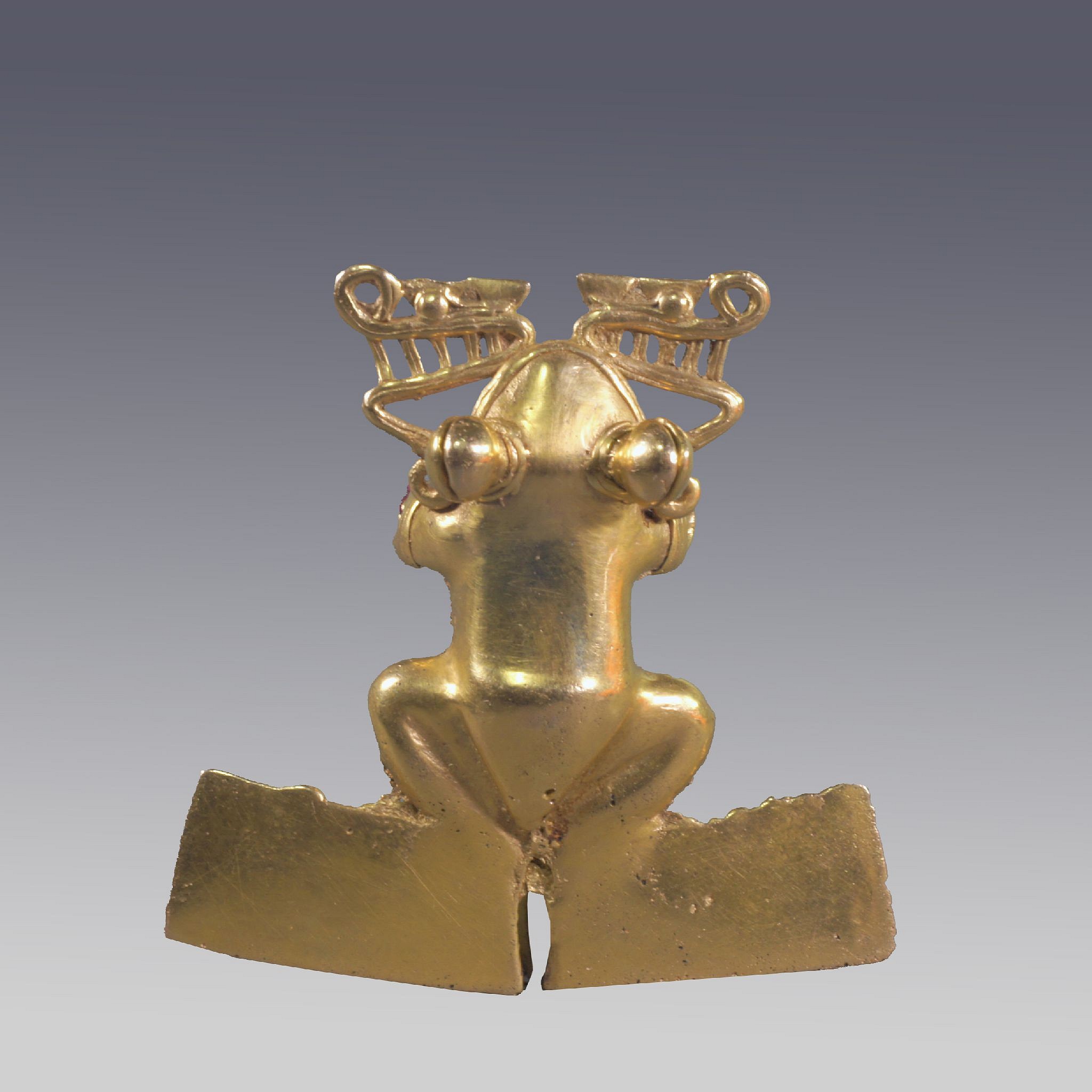
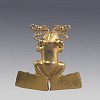


Panama, Diquis Gold Frog With Large Hind Flippers and Bulbous Eyes
The Frog has a classic body with his front legs becoming the suspension loops. From the mouth emanate two saurian heads back to back, with a mythological significance. The eyes each have a solid pellet inside to make noise when the frog is being worn. A similar example is illustrated in the Catalog, BETWEEN CONTINENTS/BETWEEN SEAS: Precolumbian Art of Costa Rica, fig. 287. A similar frog is also the Rockefeller Collection at the Metropolitan Museum of Art. Originally photographed by Justin Kerr #3081, 2001.
Period: Panama, Diquis, c. AD 1000 - 1500
Media: Metal
Dimensions: Length: 3 3/4" x Width:3 1/2" Weight: 65 grams
XRF Au.68.5% Ag.03%, Cu. 31%
Price Upon Request
n4028
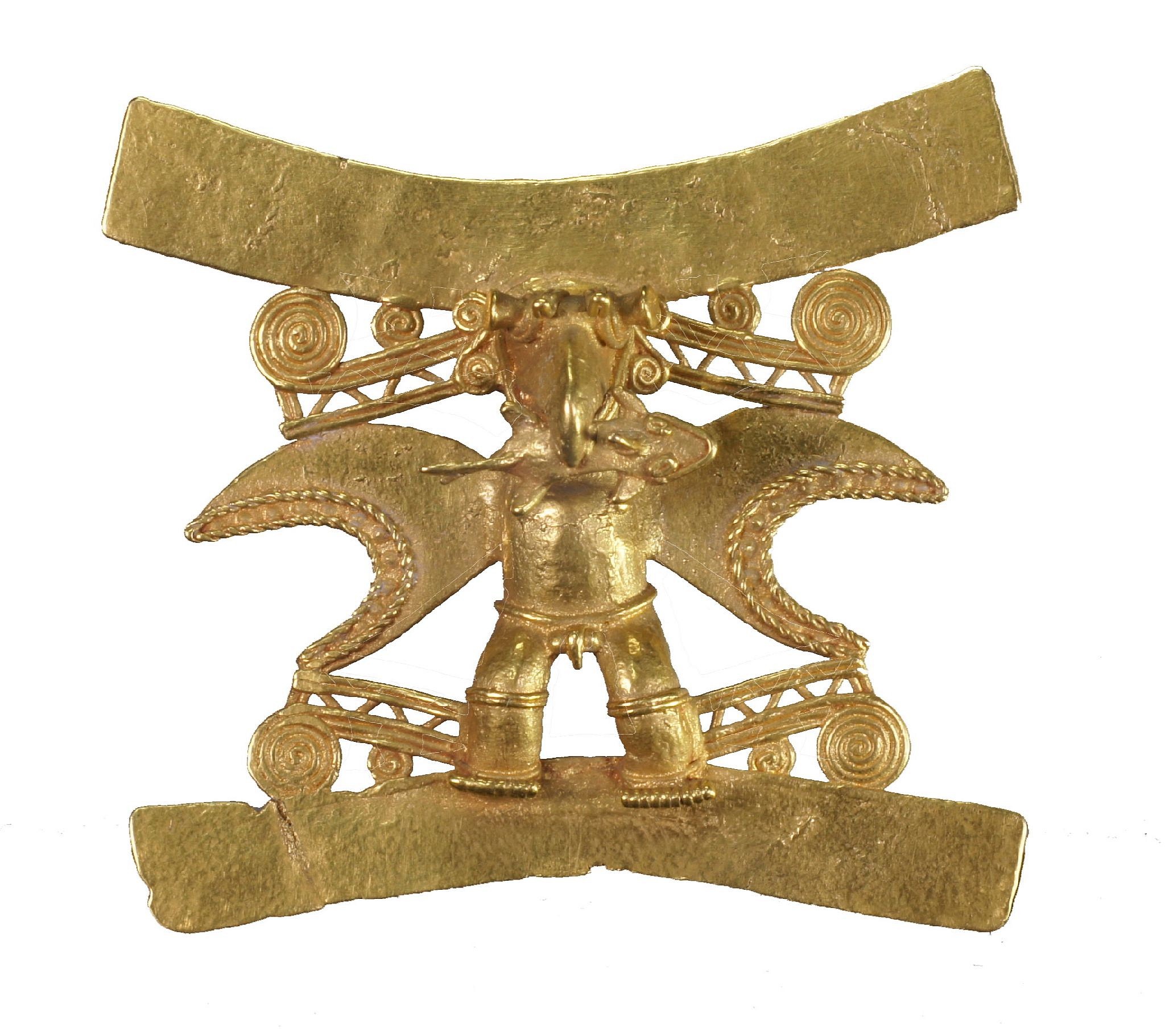







Panama, Diquis Gold Figural Pendant Wearing a Raptor Bird Mask
The pendant is an excellent example of the Lost Wax casting technique. The imposing figure has typical Diquis style "C"-shaped wings with crocodile heads emanating from behind the head and feet. The figure is probably a male shaman in transition for flight to the other world. This pendant is illustrated in THE ART OF PRECOLUMBIAN GOLD- The Jan Mitchell Collection, pg. 105, and also in POWER OF GOLD, p. 72. Another similar example of a Diquis pendant with with a bat's head is illustrated in Between the Continents/Between Seas: PRECOLUMBIAN ART OF COSTA RICA, plate 93. Another very similar piece is in the Denver Art Museum. Ex. New York collector, prior to 1970.
Period: Panama, Diquis, c. AD 1000 - 1500
Media: Metal
Dimensions: Height: 31/4" x Width: 31/2" Weight: 97grams
XRF: Au. 90.6%, Ag.6.3%, Cu. 2.8% Pt. Platimum 1.03%
Price Upon Request
n7055
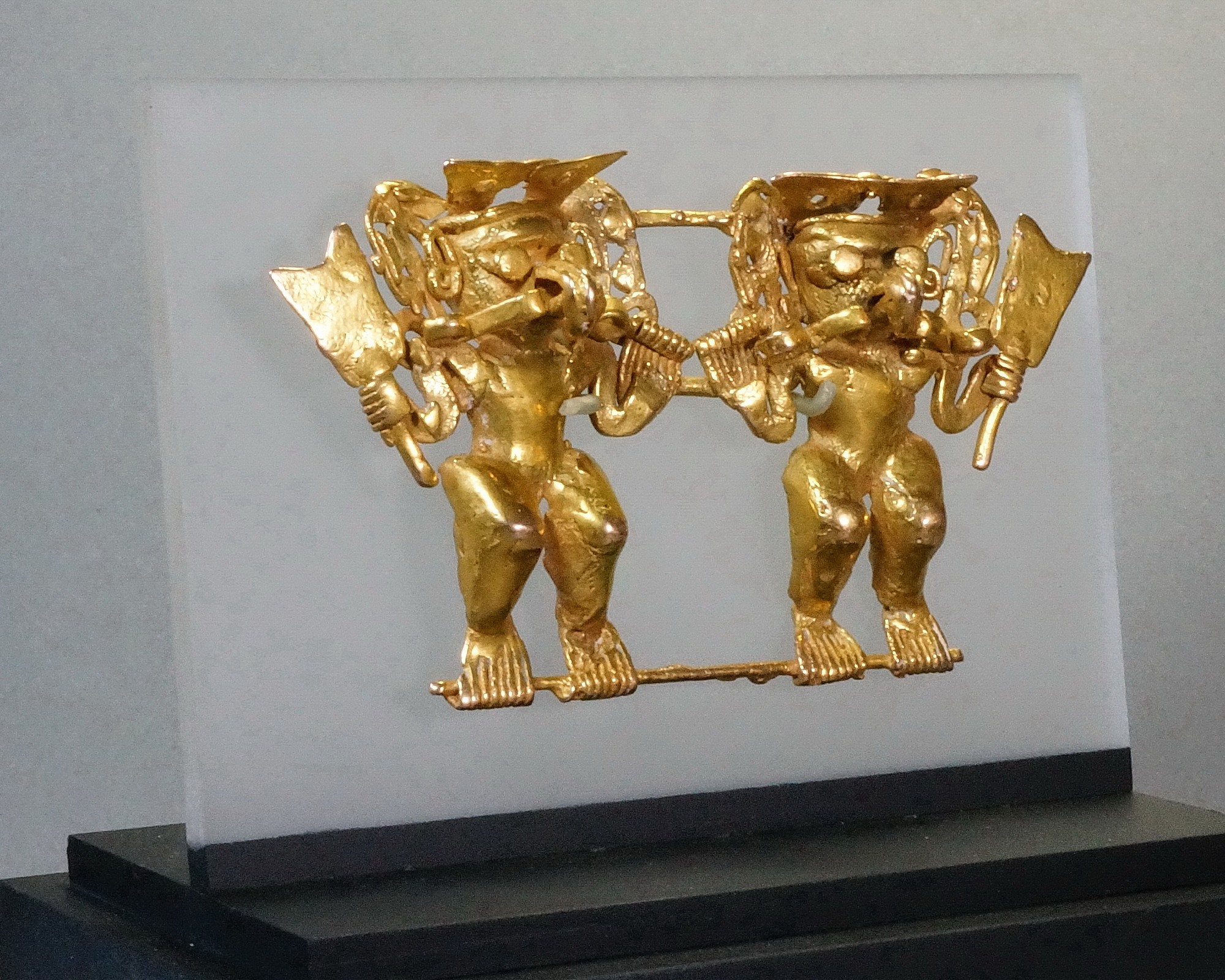




Panama, Cocle Cast Gold Anthropmorphized Twin Warriors
Each warrior has human bodies with bird-like facial features. They are wearing headdresses with undulating serpents and holding a typical paddle-like standard. There are curved bands emanating from each of the warrior's mouths. The warriors have beaked noses, representing transformation into condors. Ex. New York collector, prior to 1970. Two examples of attached figures are in the Met Museum.
Period: Panama, Cocle, c. AD 800 - 1200
Media: Metal
Dimensions: Height: 2" x Width: 4" Weight: 62.5 grams.
Price Upon Request
n7033
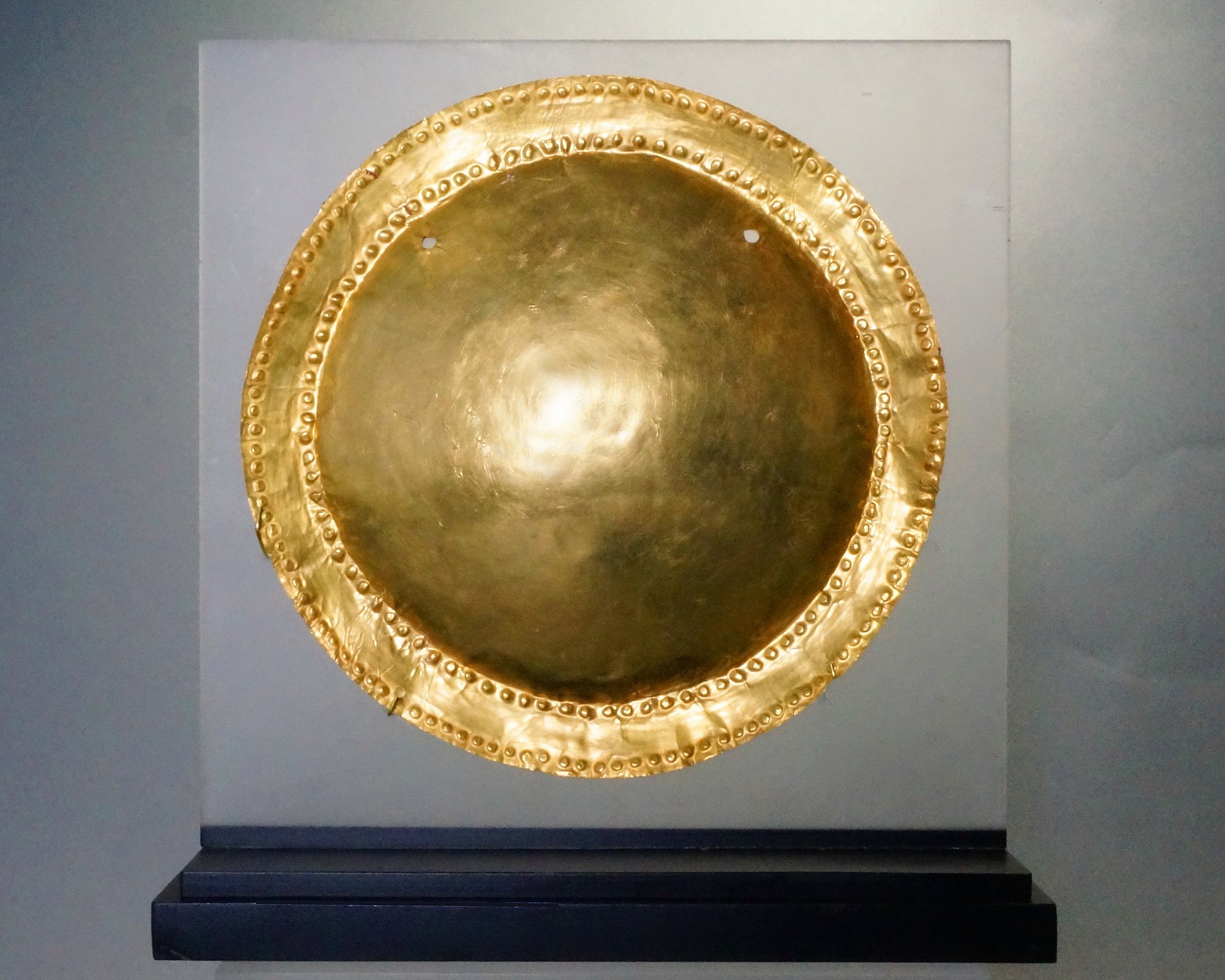




Panama, Macaracas (Cocle) Circular Gold Disc With Concave Center
The disc is embellished with two bands of small bosses on the narrow rim. There is a pair of suspension holes. On Columbus’ 4th voyage off the coast of Panama, he and his men saw Indians wearing "Mirrors of gold." Illustrated in THE ART OF PRECOLUMBIAN GOLD, p. 119. Ex New York collector, prior to 1970.
Period: Panama, Macaracas, c. AD 800 - 1000
Media: Metal
Dimensions: Diameter 5 3/8" 24.6 Weight: grams
Price Upon Request
n7058
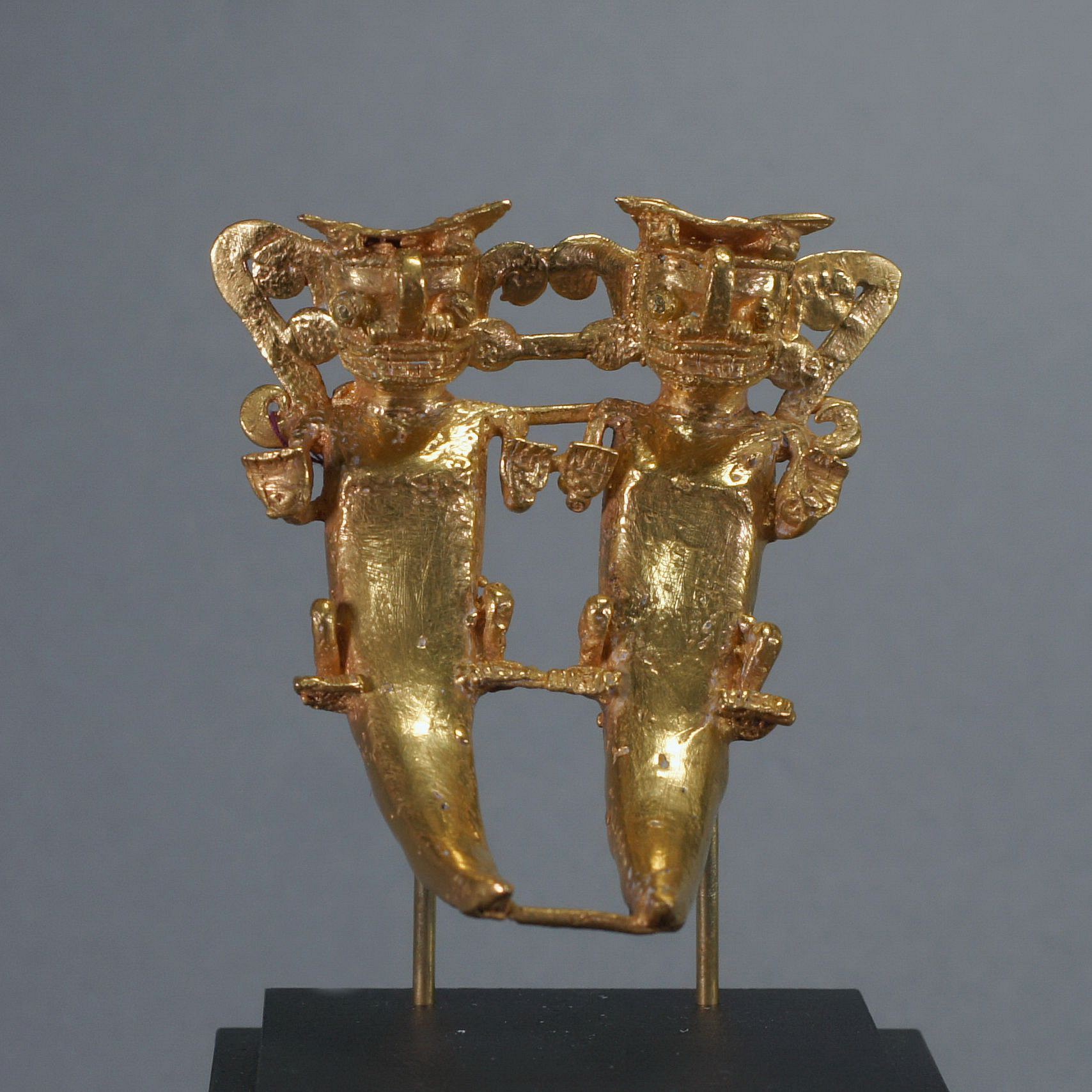
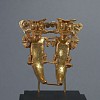



Panama, Cocle Cast Gold Pendant of Pair Anthropomorphized Bats
Lost Was cast depicting paired figures with bat faces, human hands, and a corcodilian body and tail. Duality was a known belief of the natural world: male and female, night and day, heaven and earth. Bats are nocturnal creatures and ruled the darkness. There are two cast suspension loops behind each outside shoulder. Ex. New York collector, prior to 1970.
Period: Panama, Disquis, c. AD 1200 - 1500
Media: Metal
Dimensions: Width 2 3/4" x Length: 3 1/8" Weight 100.6 grams
XRF
Price Upon Request
n7027
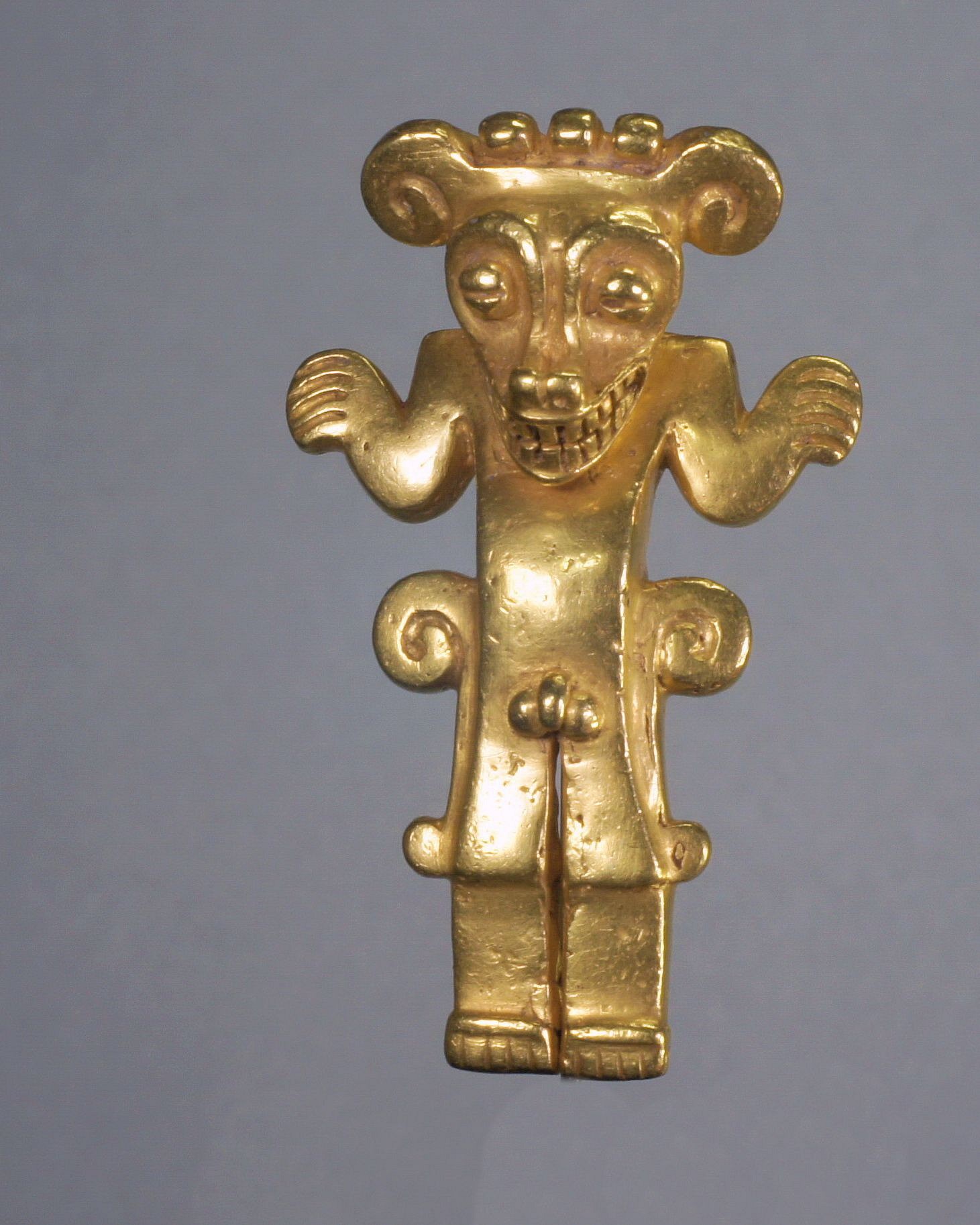









Costa Rica, Diquis Style Cast Gold Figure of a Shaman Wearing an Crocodile Mask
This is a hollow lost wax cast figure that has a relatively thick wall. It has two casting chaplets on the back that can be seen clearly. The pointed upturned nose and sharp teeth are qualities of a crocodile. A crocodile from the Diquis area is illustrated in THE GOLD OF ANCIENT AMERICA, P.114. Ellen Howe wrote about this piece in A RADIOGTRAPHIC STUDY OF HOLLOW CAST GOLD PENDANTS FROM SITIO CONTE in the 45th Congress of Americanists, Bogota 1985, pg. 190-200, where she C-14 tested the carbon core and took radiographs. Ex. New York collector, prior to 1970.
Period: Panama, Diquis, c. AD 1200 - 1500
Media: Metal
Dimensions: Height: 3" x Width: 2.85" Weight: 63 grams
XRF: Au. 89.7%, Ag. 9.9% , Cu. .02%
Price Upon Request
N7059
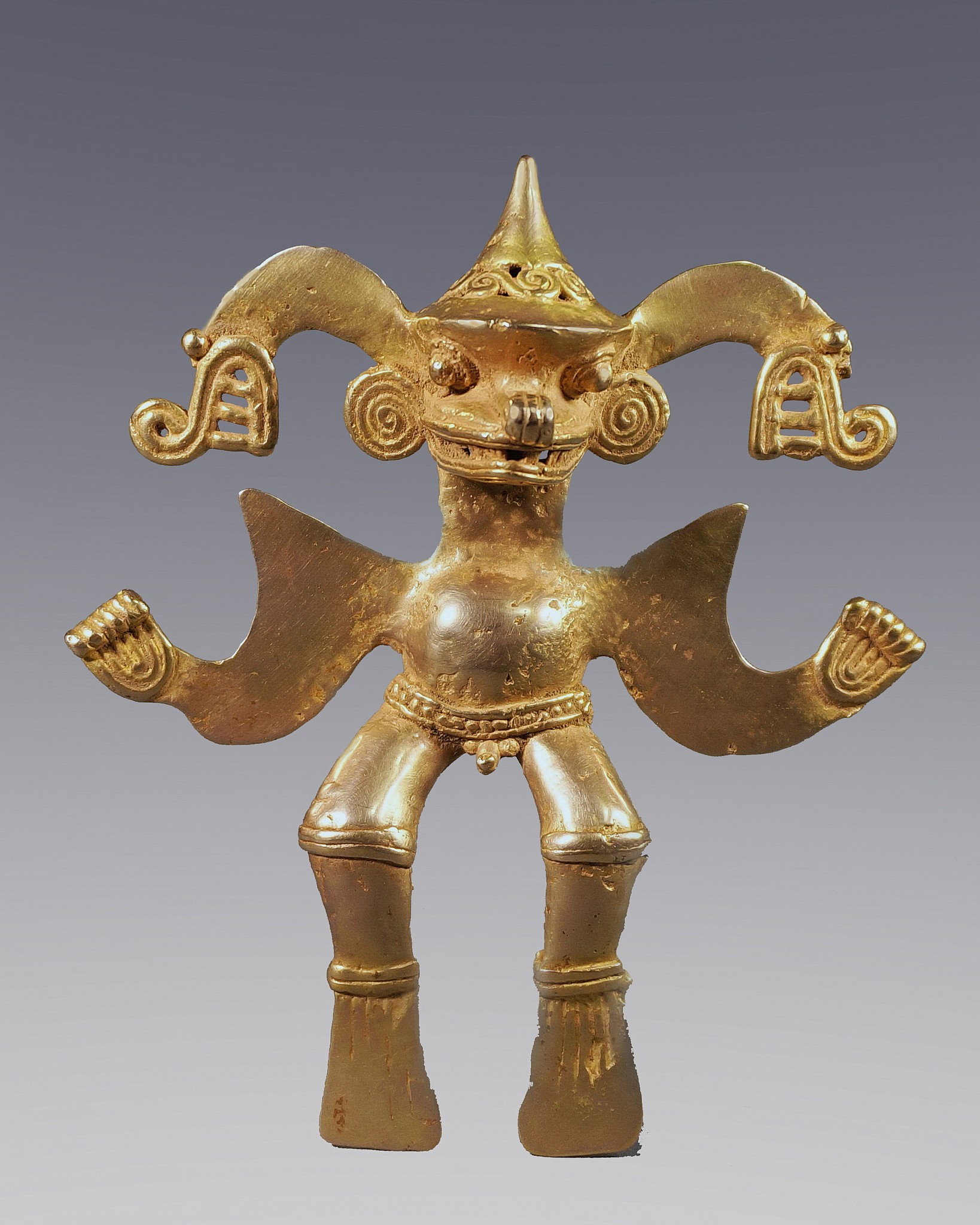


Costa Rica, Diquis Cast Gold Anthropomorphic Figure with a Cone Shaped Crown
The figure has a crocodilian nose and mouth with serpents emanating from his head and wears a cone-shaped crown. His hands are held outward with broad shoulders which could also be wings, and his flipper-shaped feet are typical of the Diquis region which borders Panama. Crocodiles, or Saurians are not often depicted as standalone figures. A very similar shaped figure, but smaller and without the helmet is illustrated in THE ART OF PRECOLUMBIAN GOLD - The Jan Mitchell Collection, #6. Another similar figure is in the Janssen Collection in Antwerp. Both have a male phallus.
Period: Panama, Disquis, c. AD 1200 - 1500
Media: Metal
Dimensions: Height: 4 3/16" x Width:3 3/4",Weight: 99.6 grams
XRF Au. 72%, Cu. 24%, Ag. 2.4%
Price Upon Request
n7031
